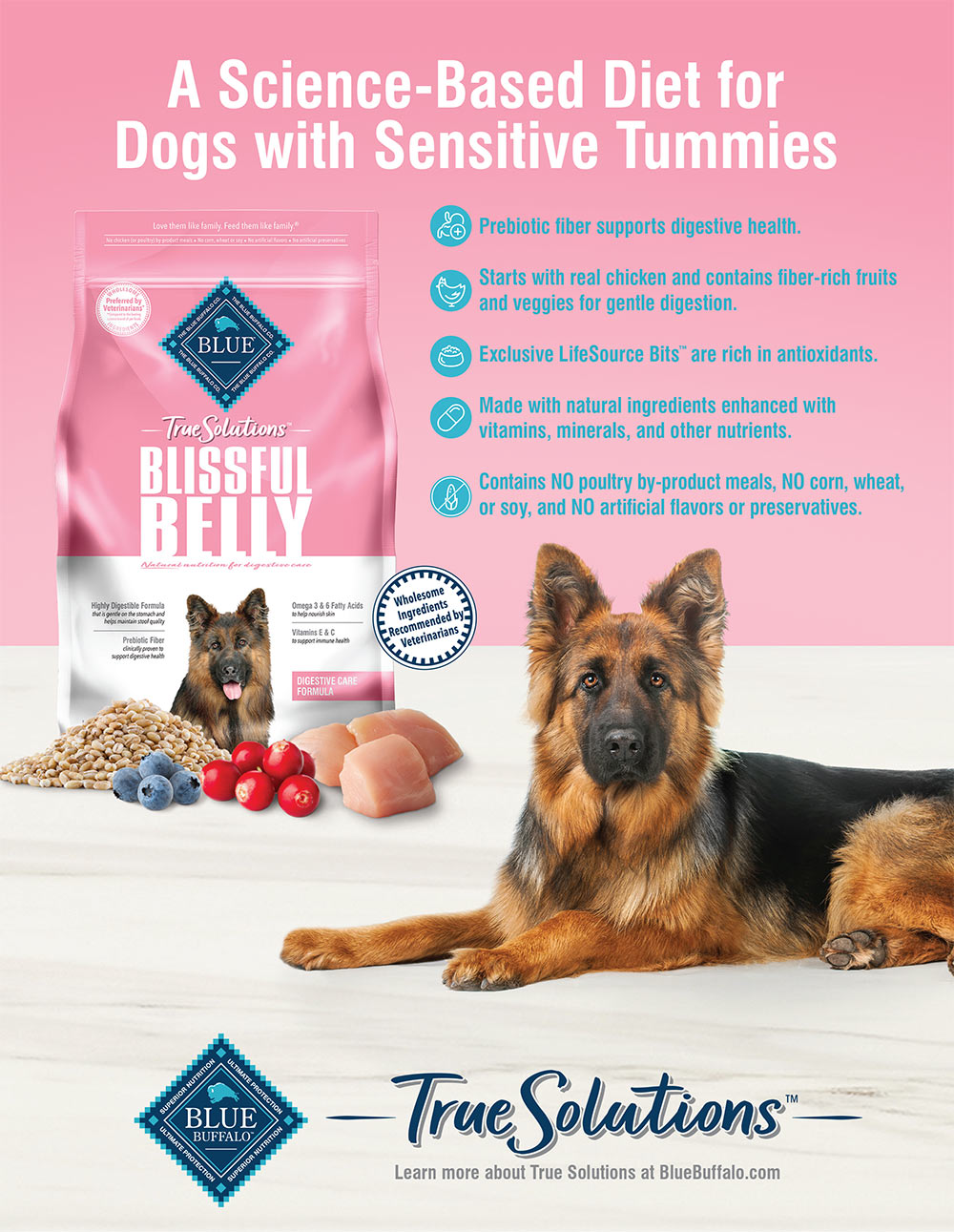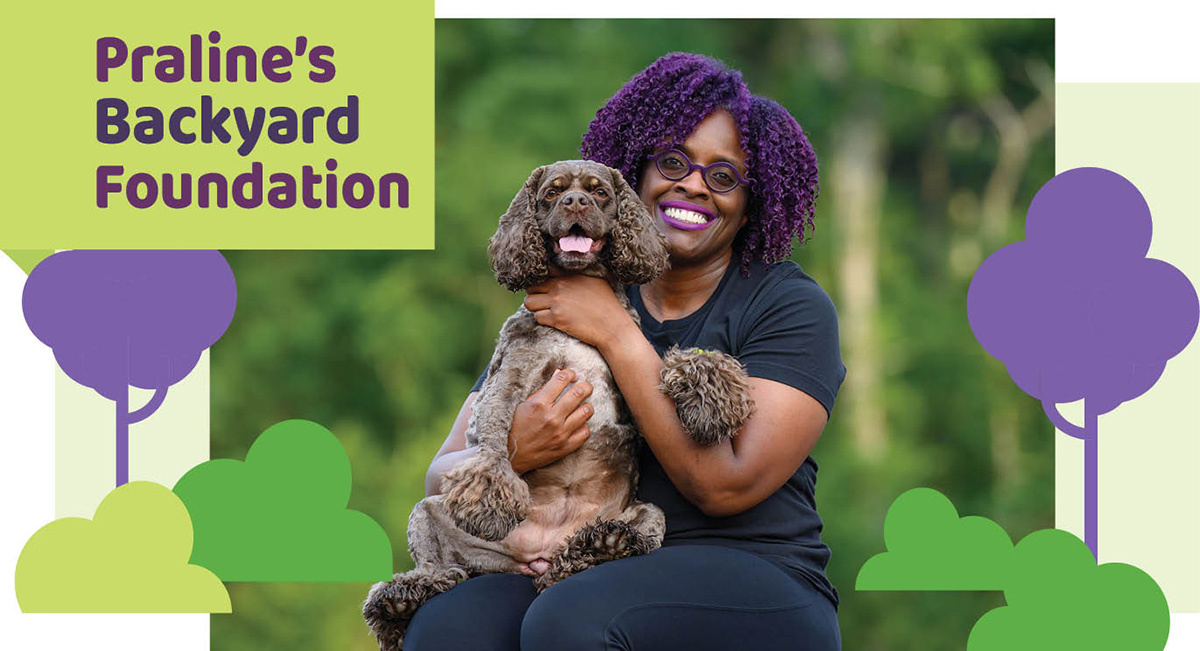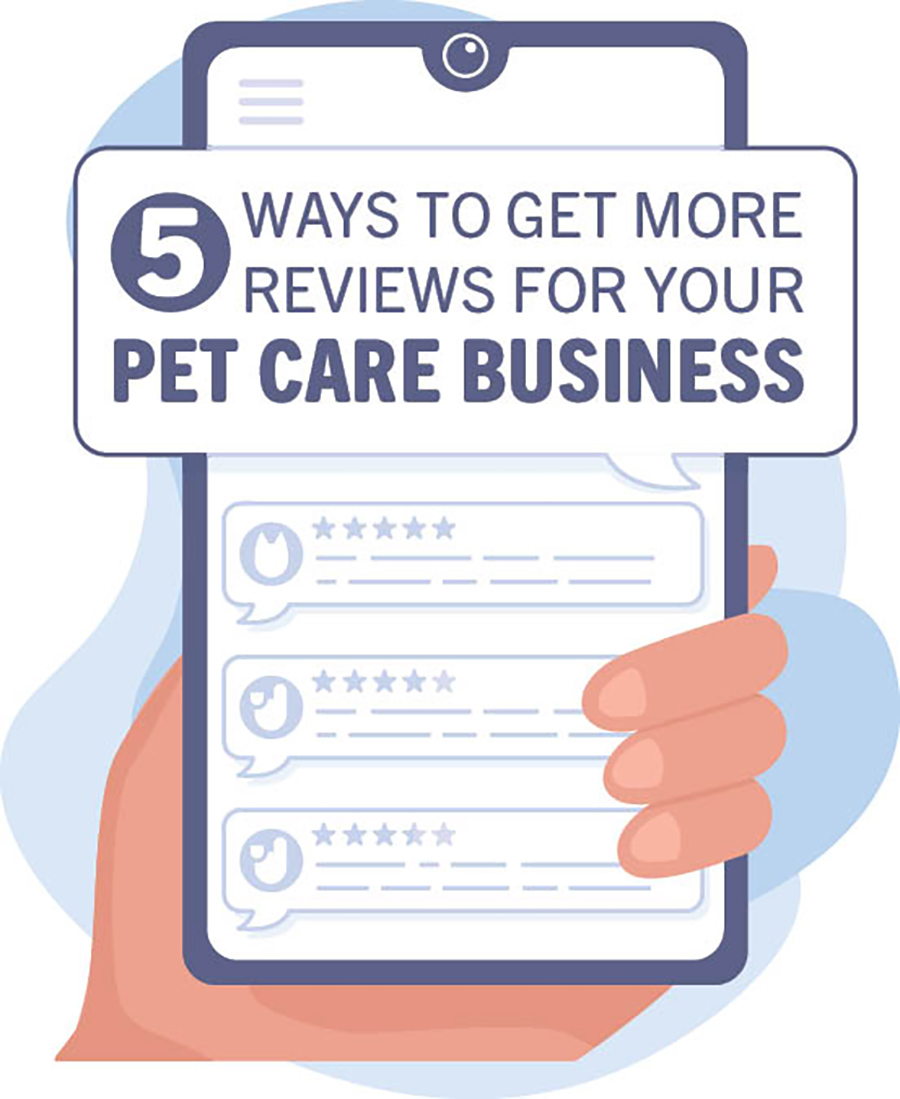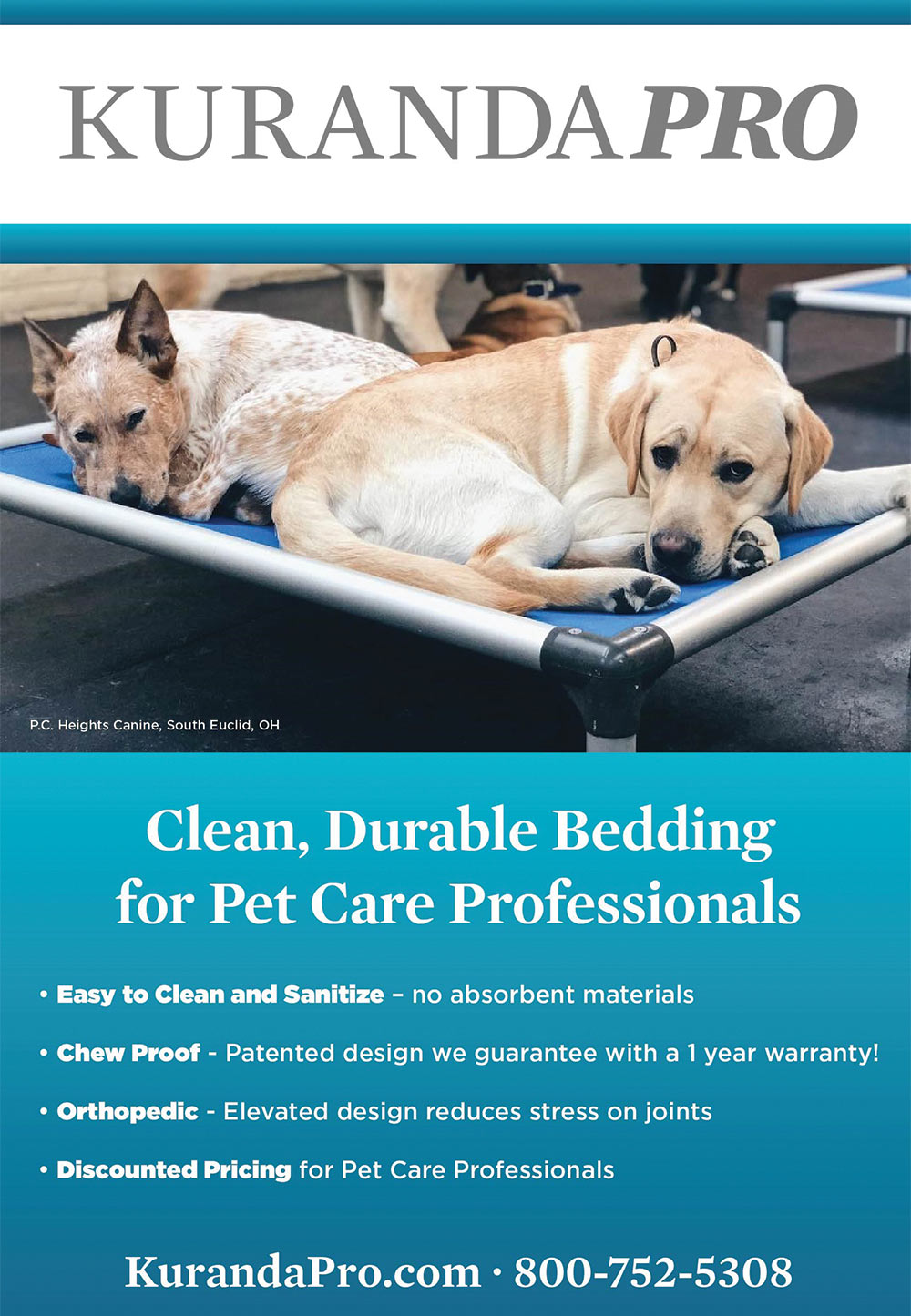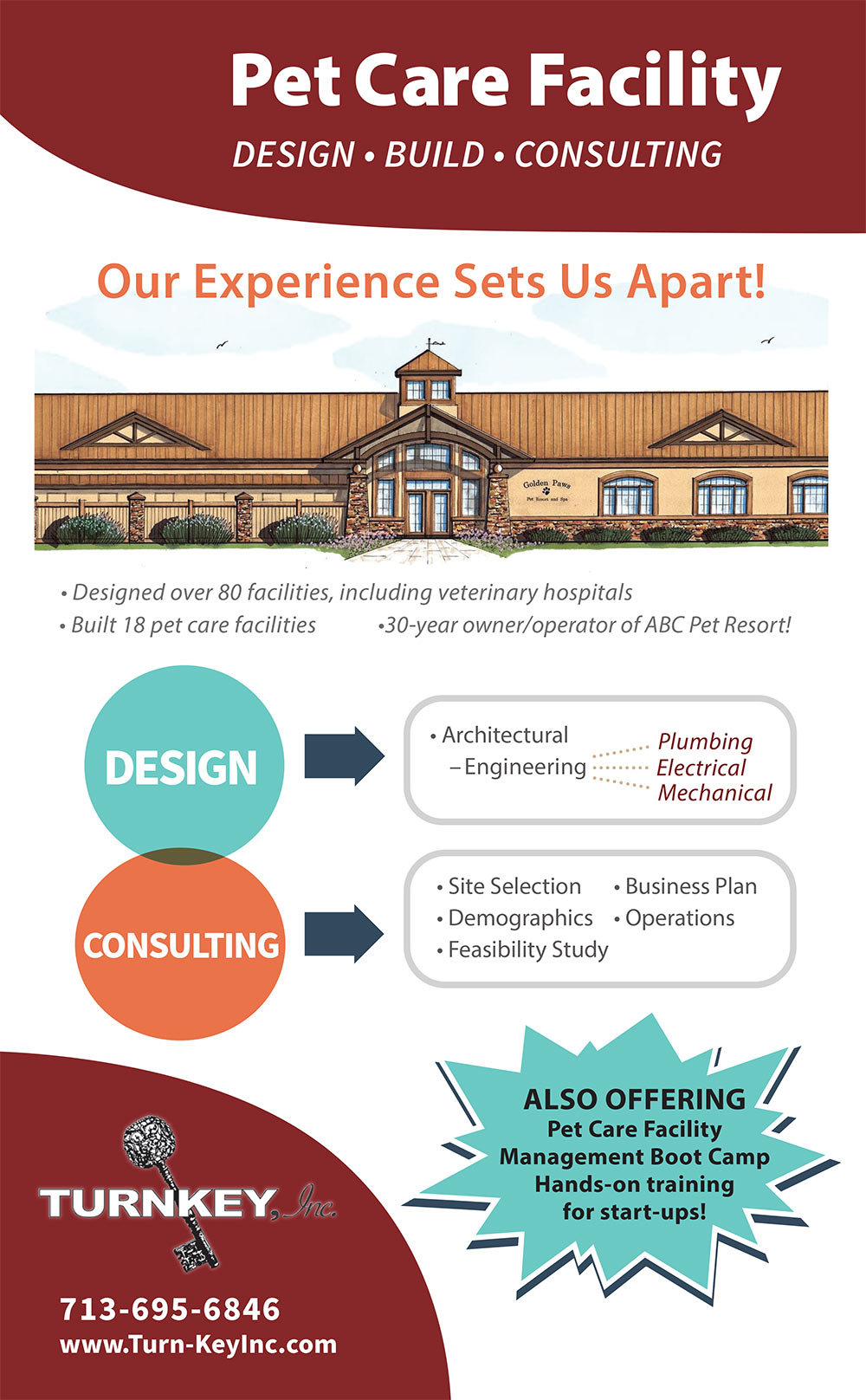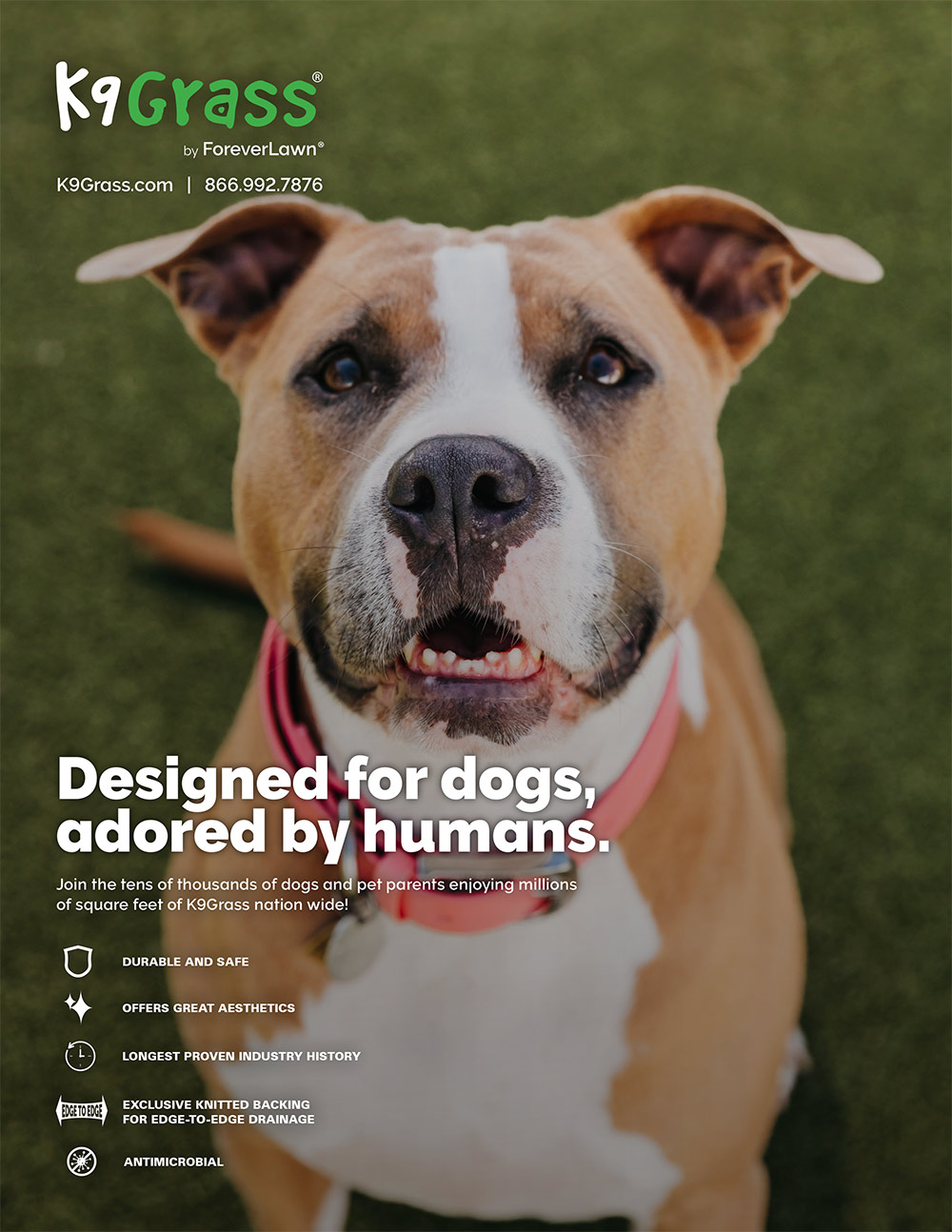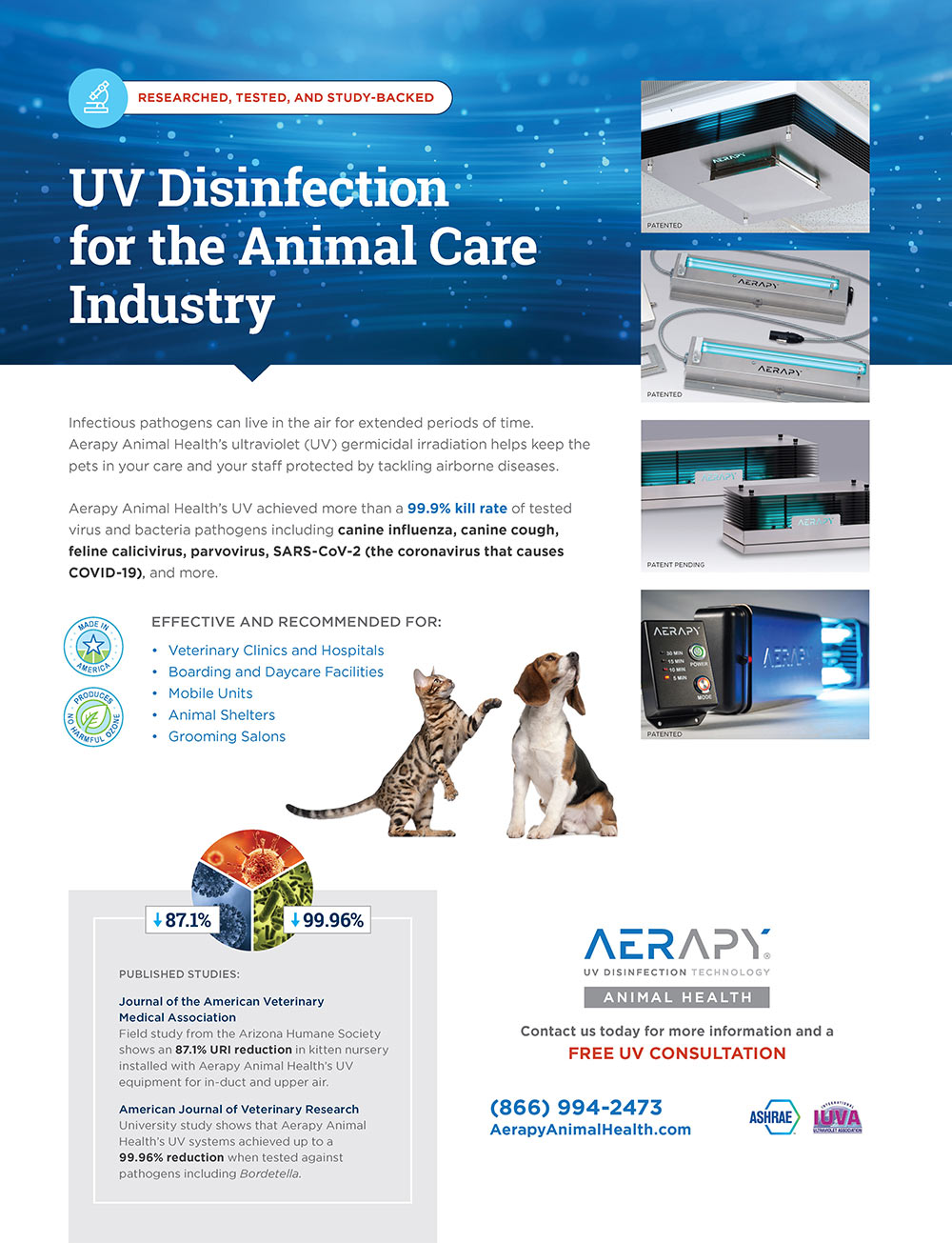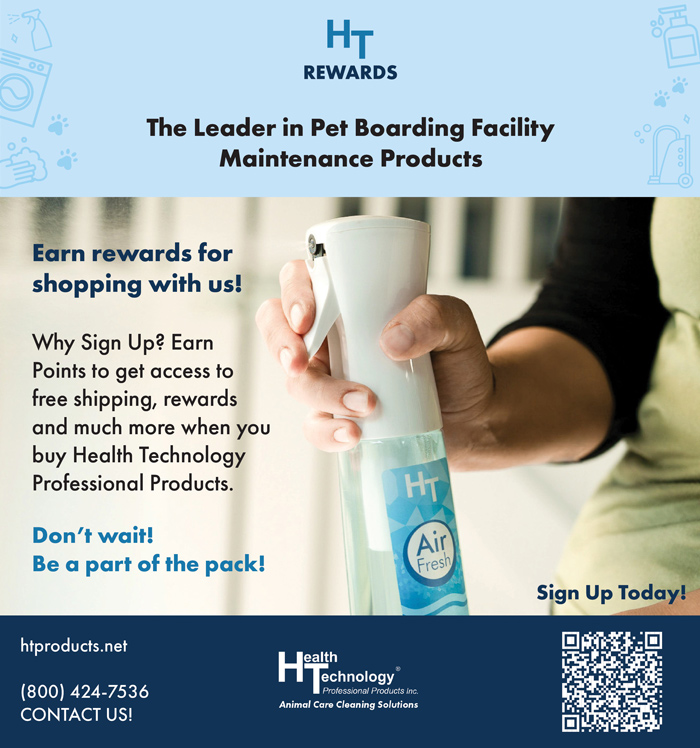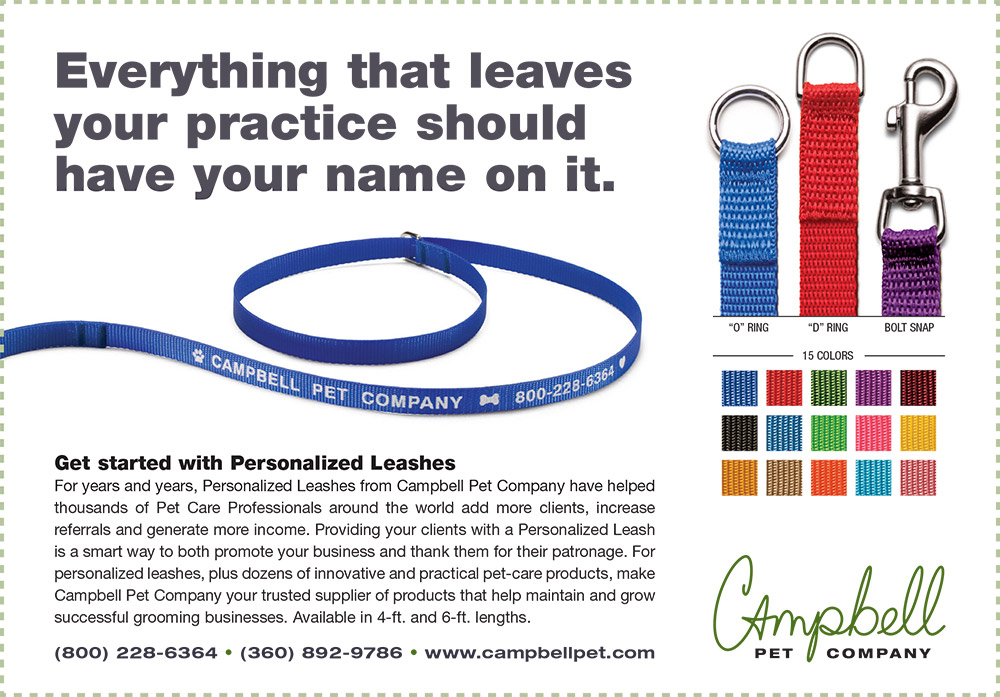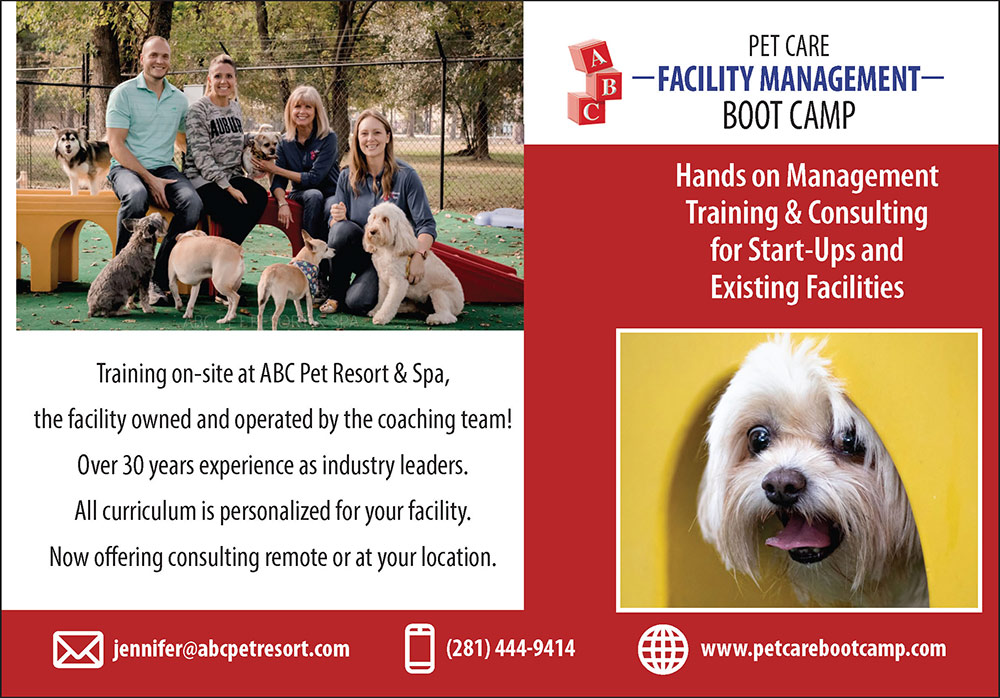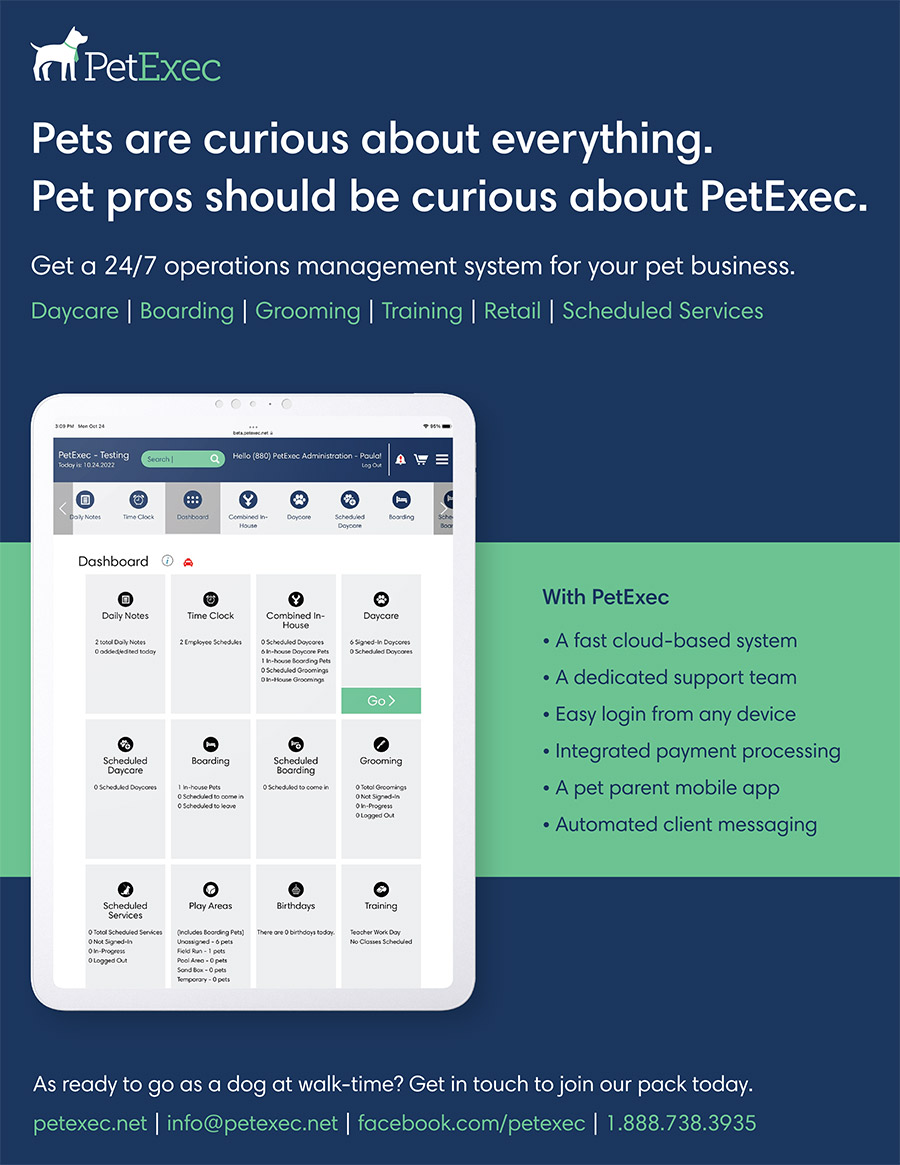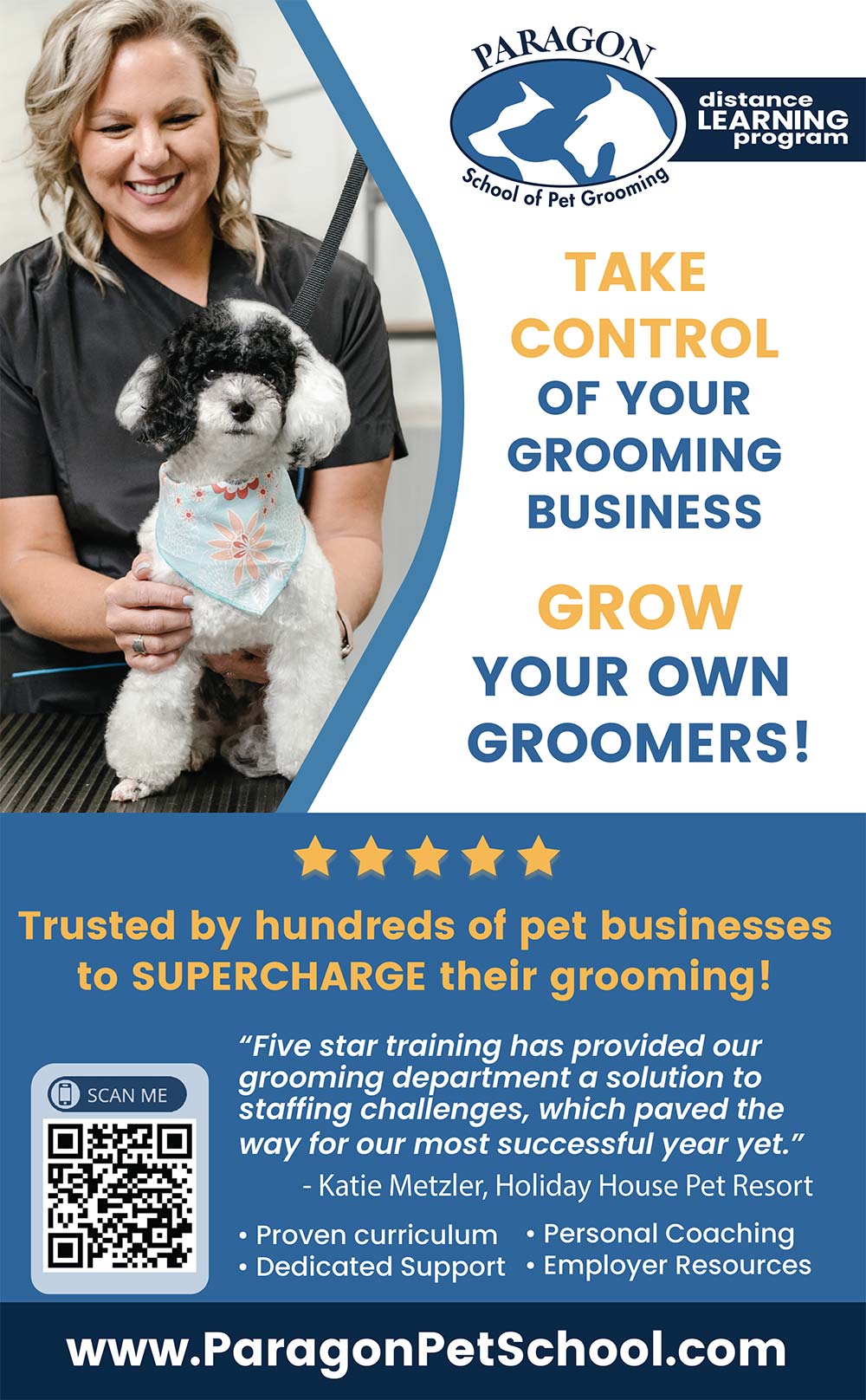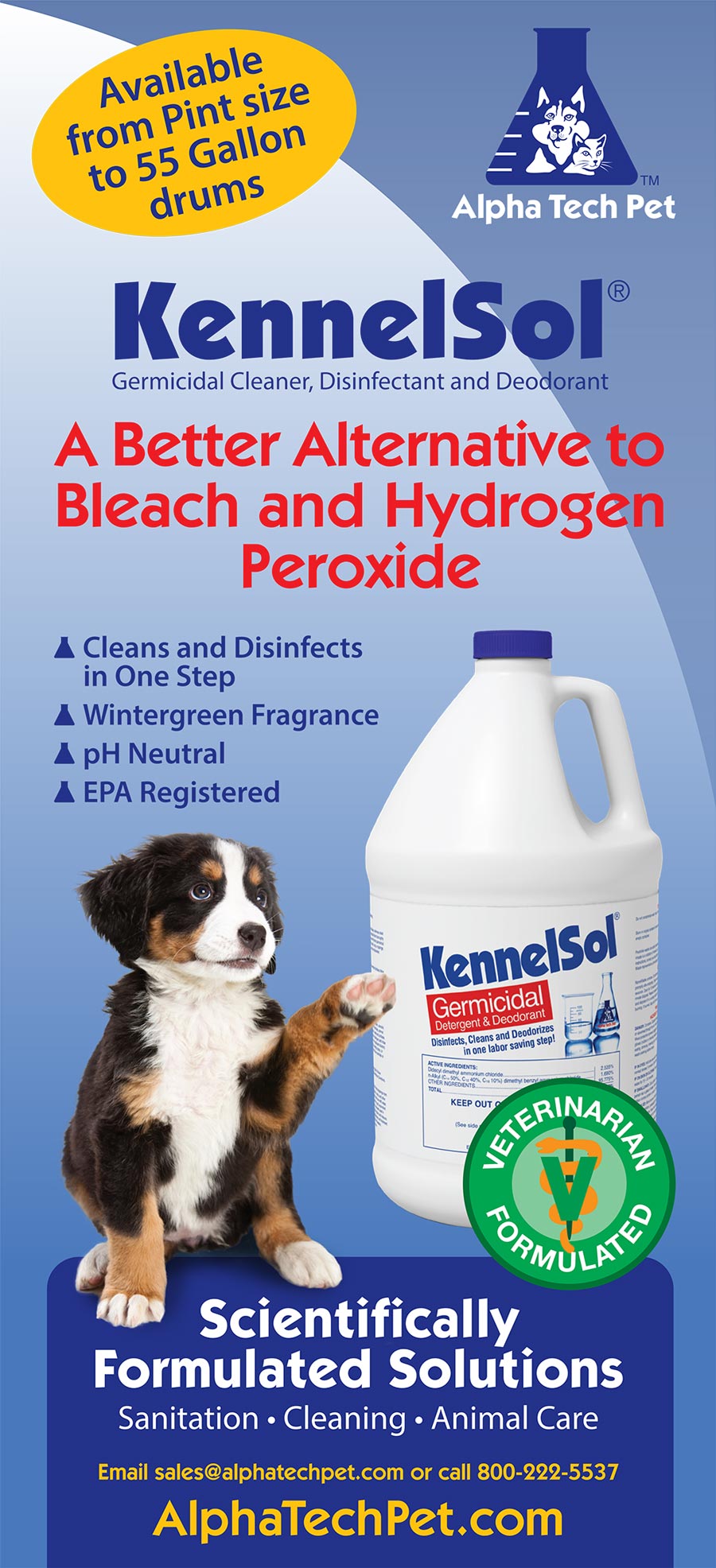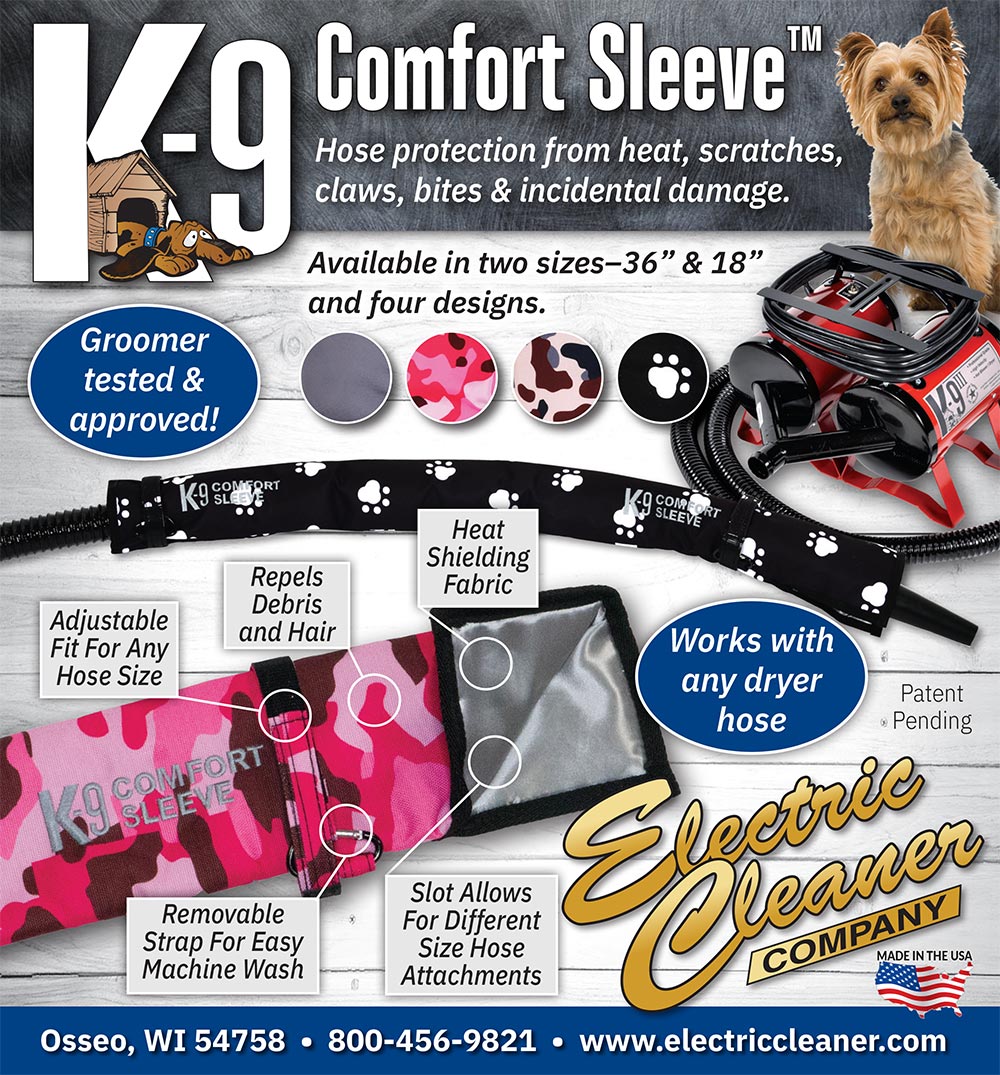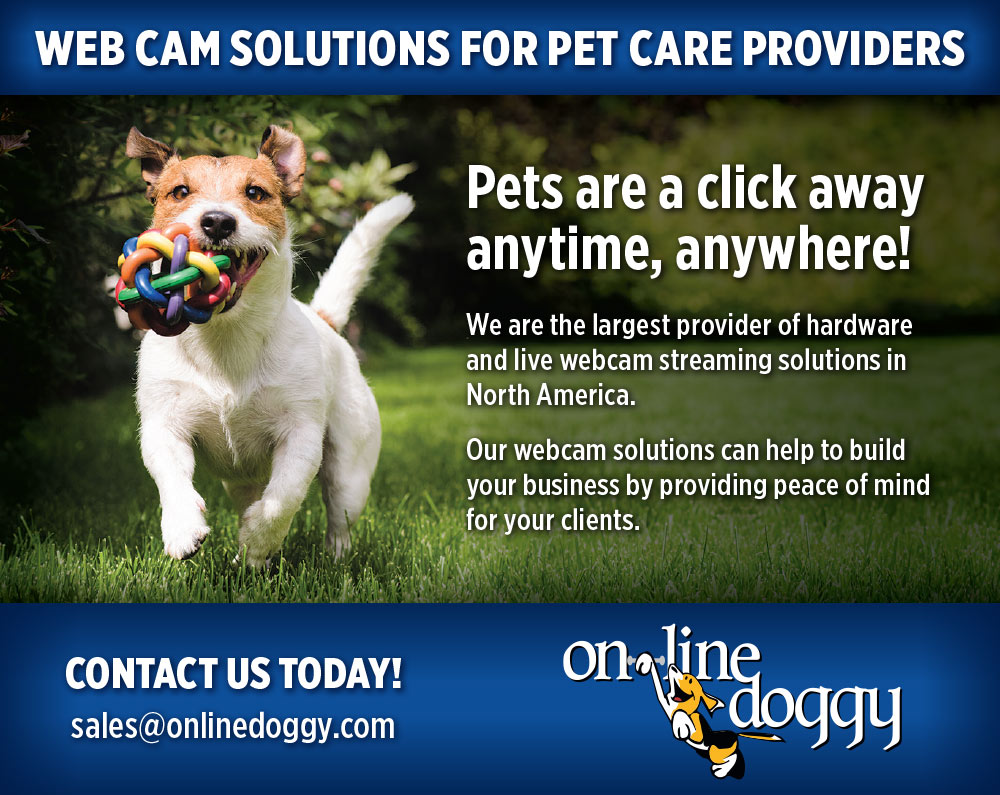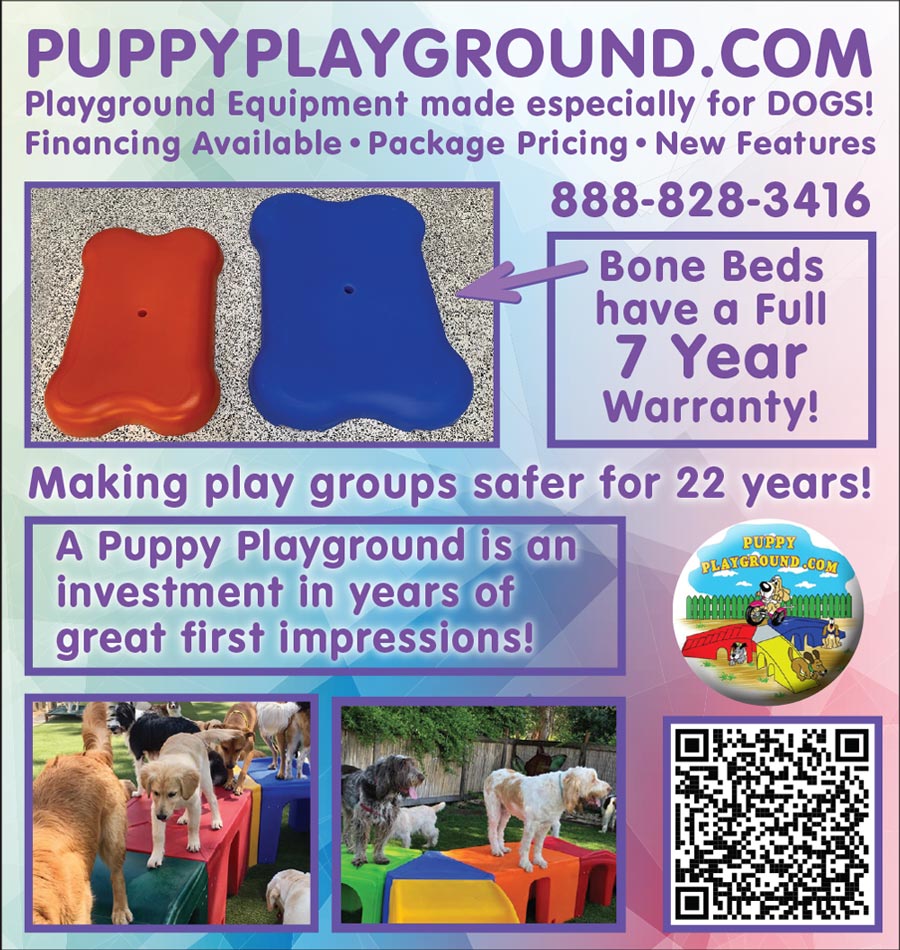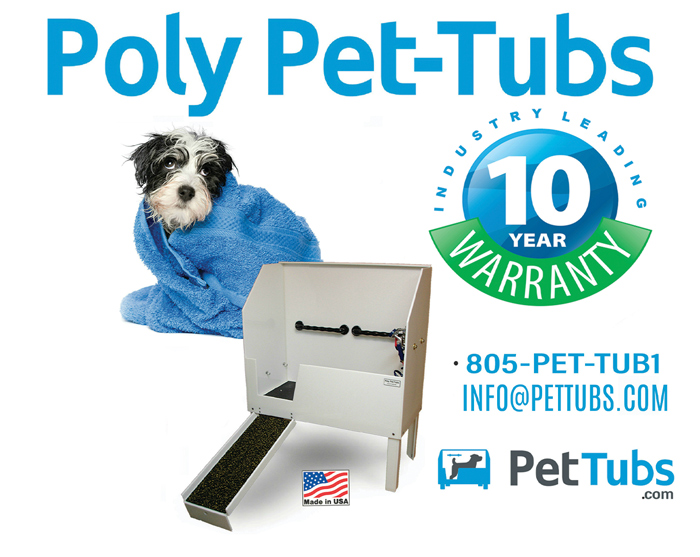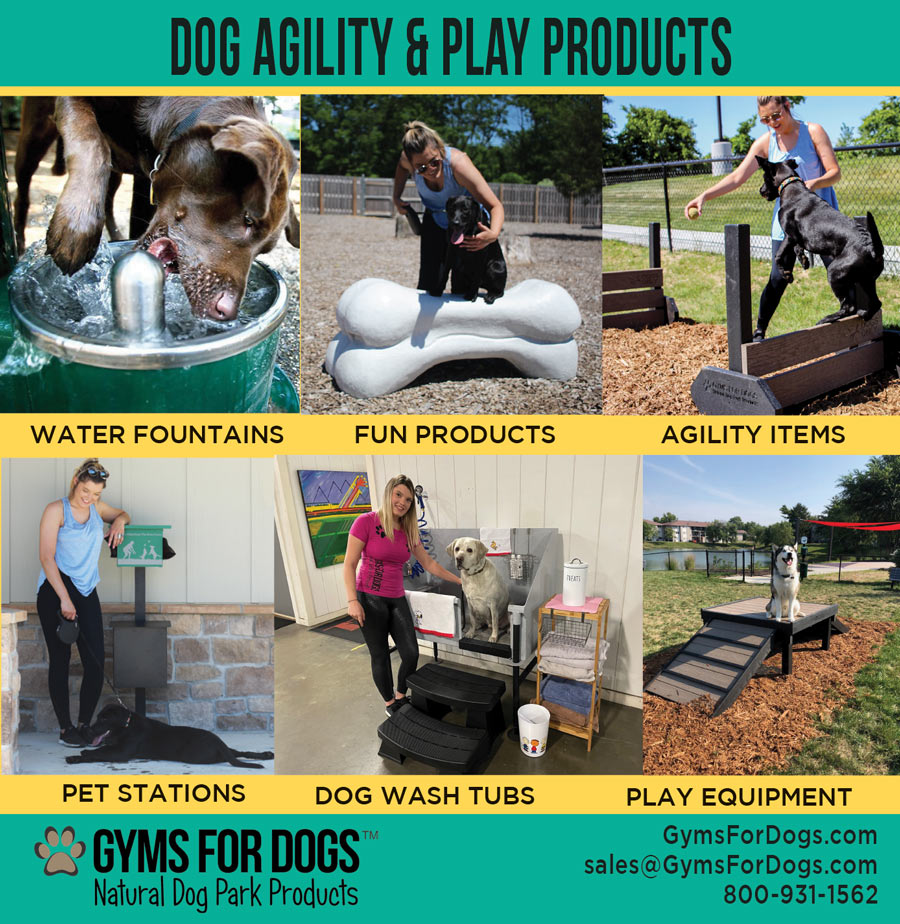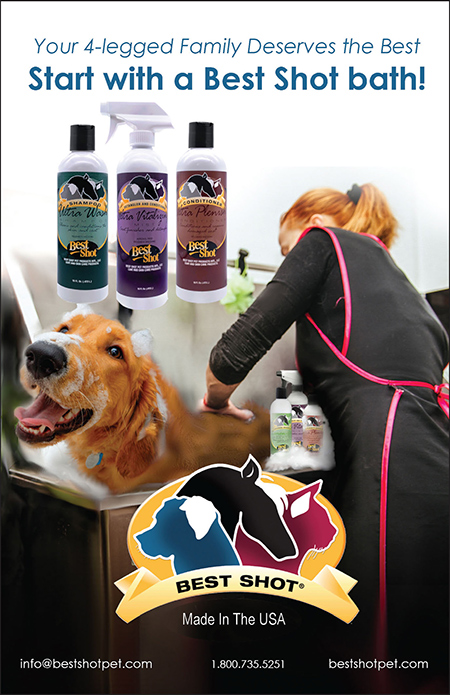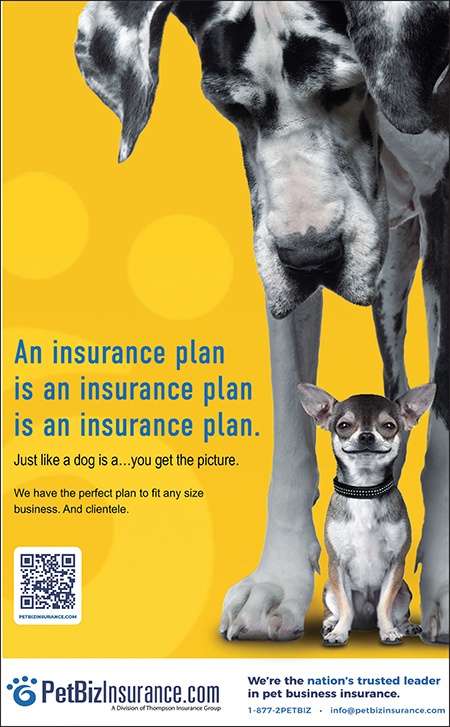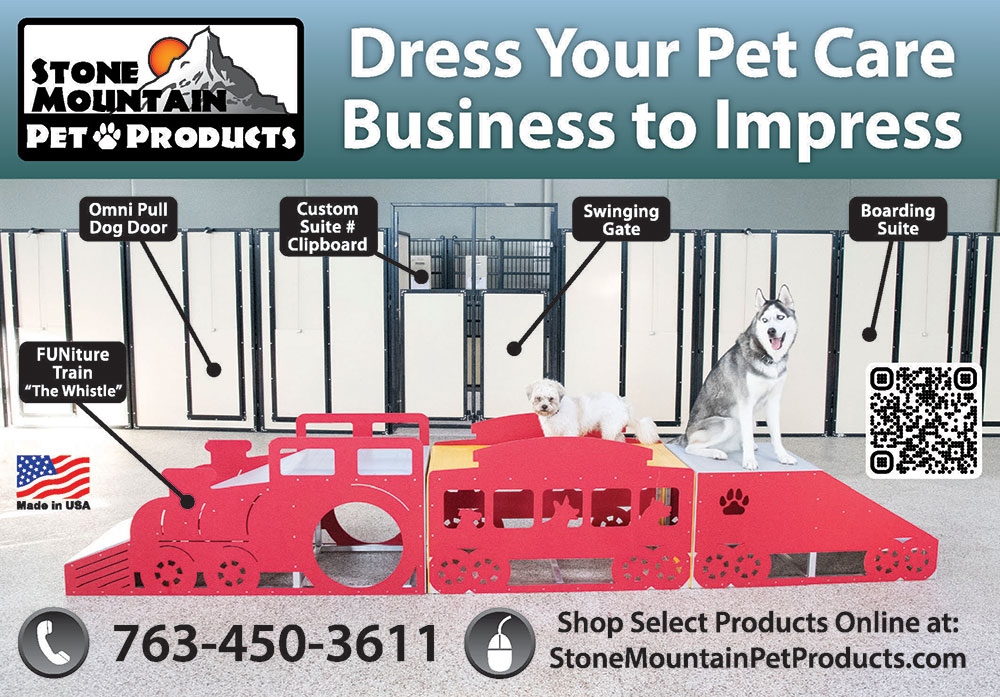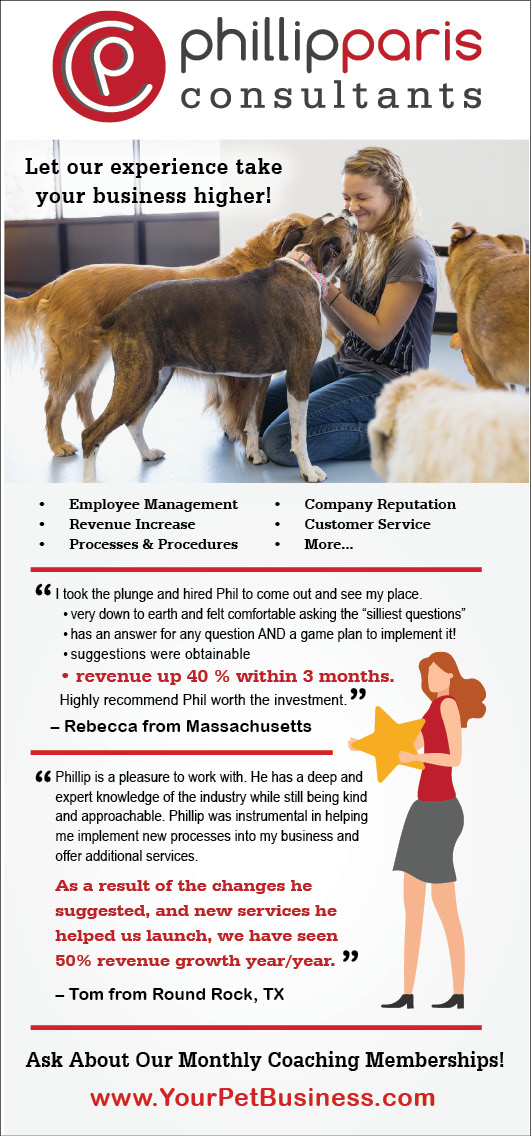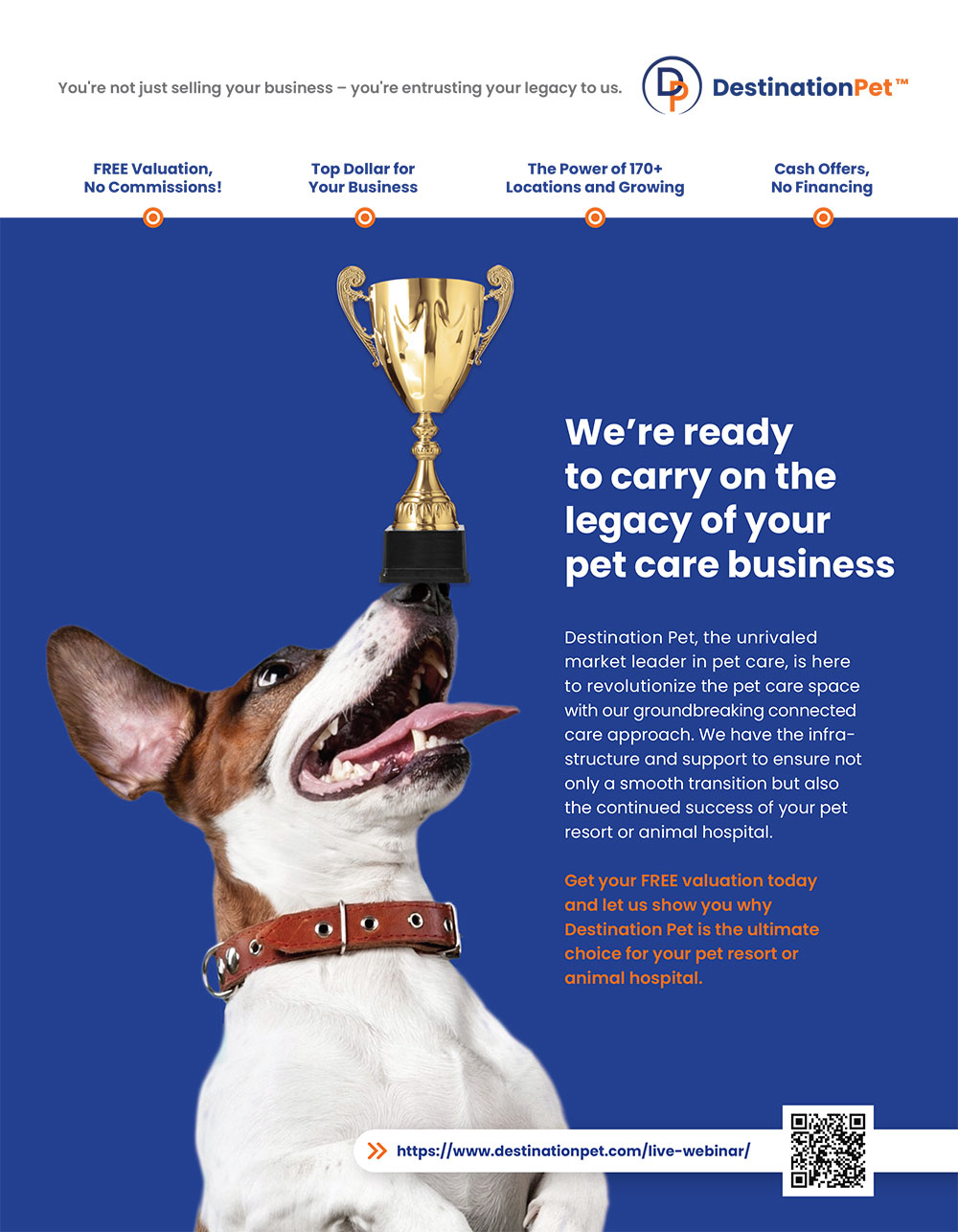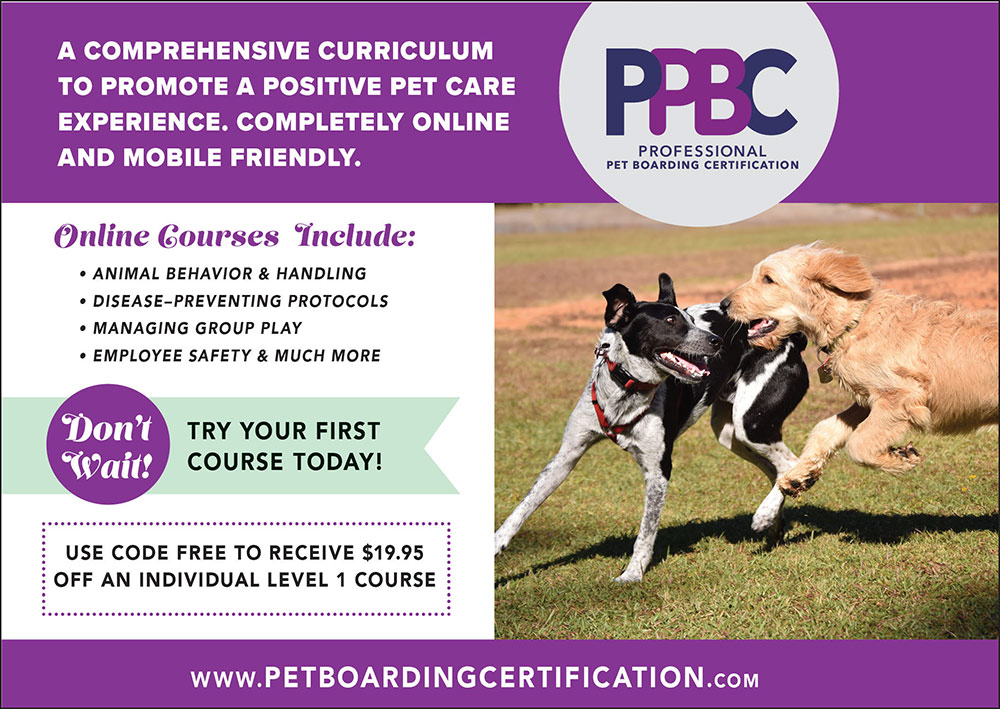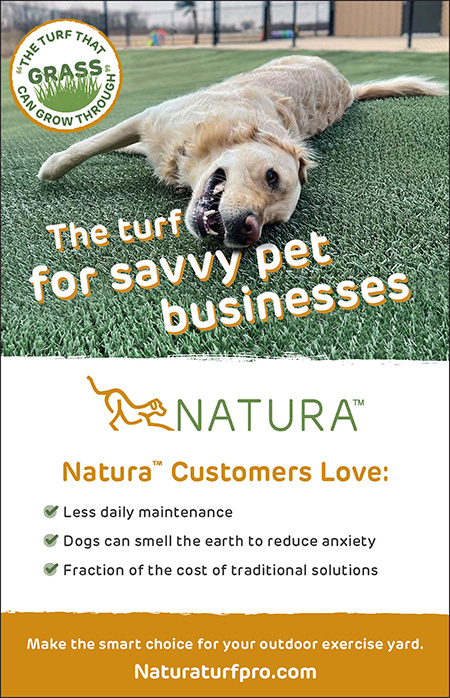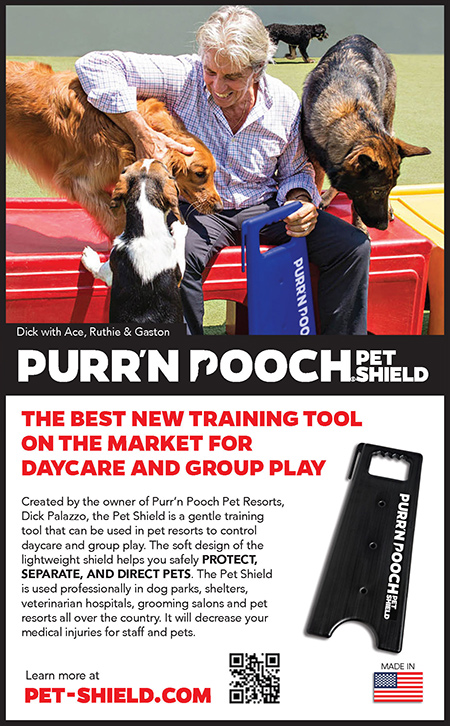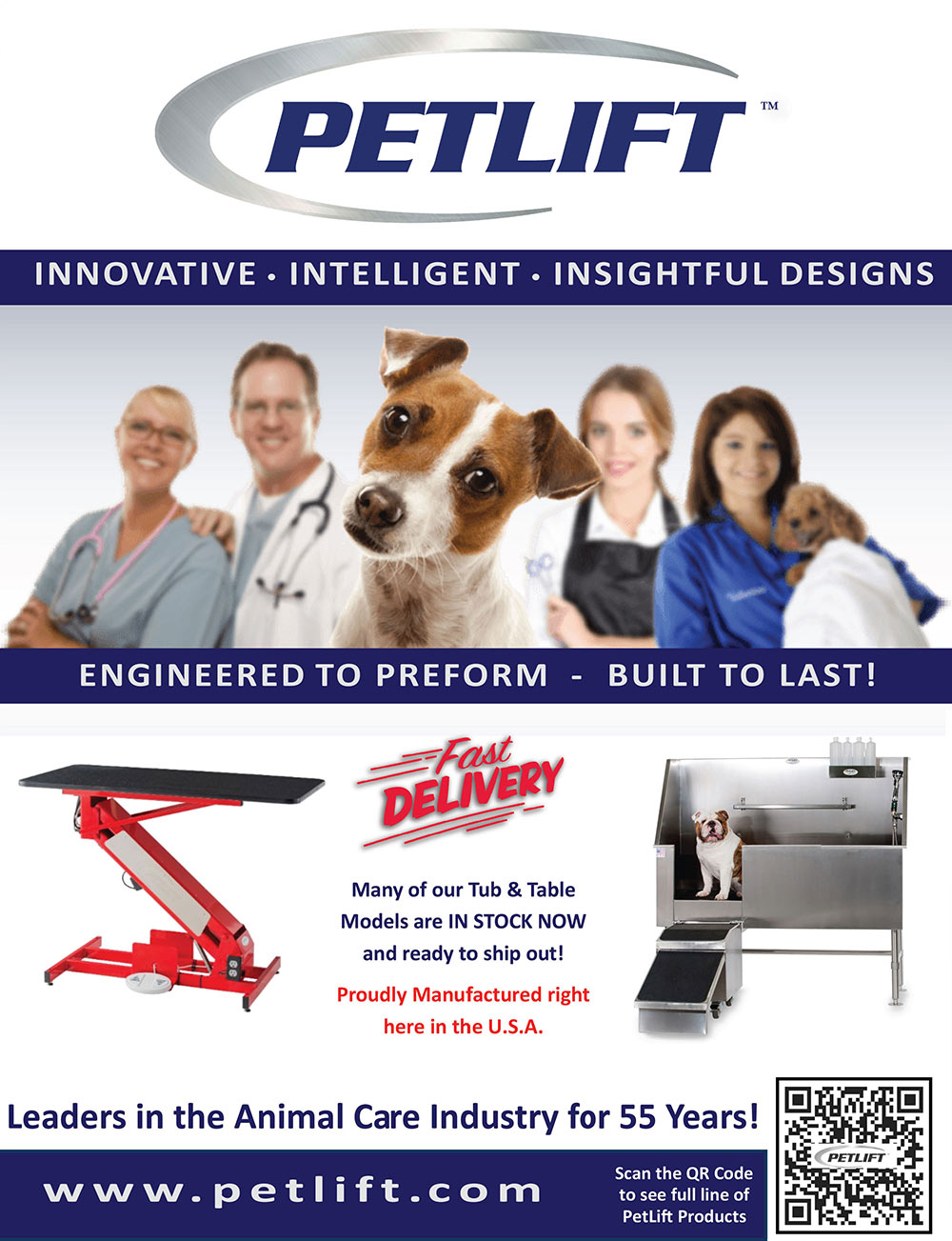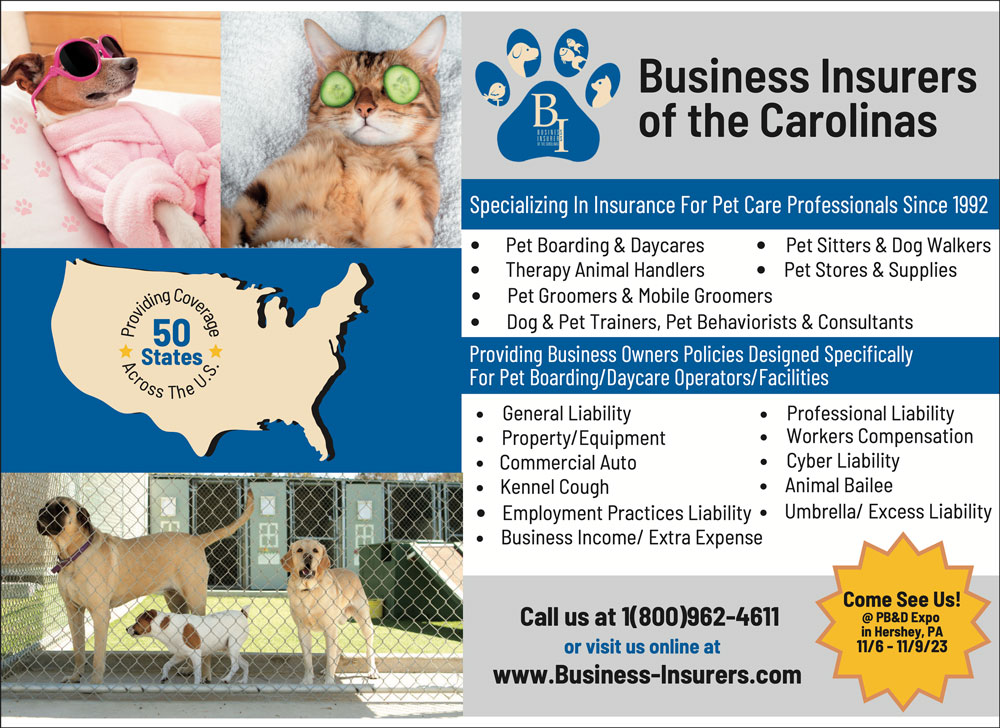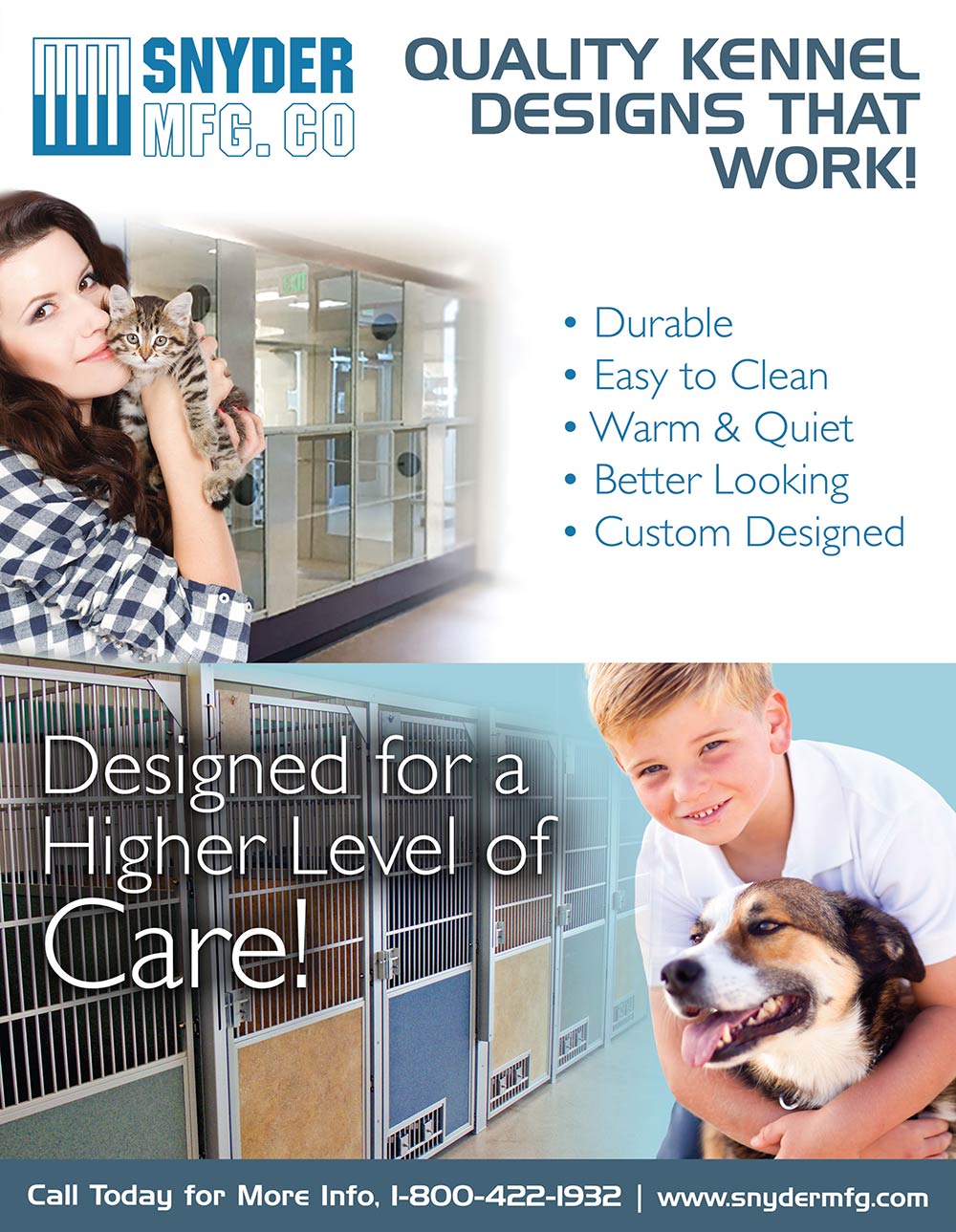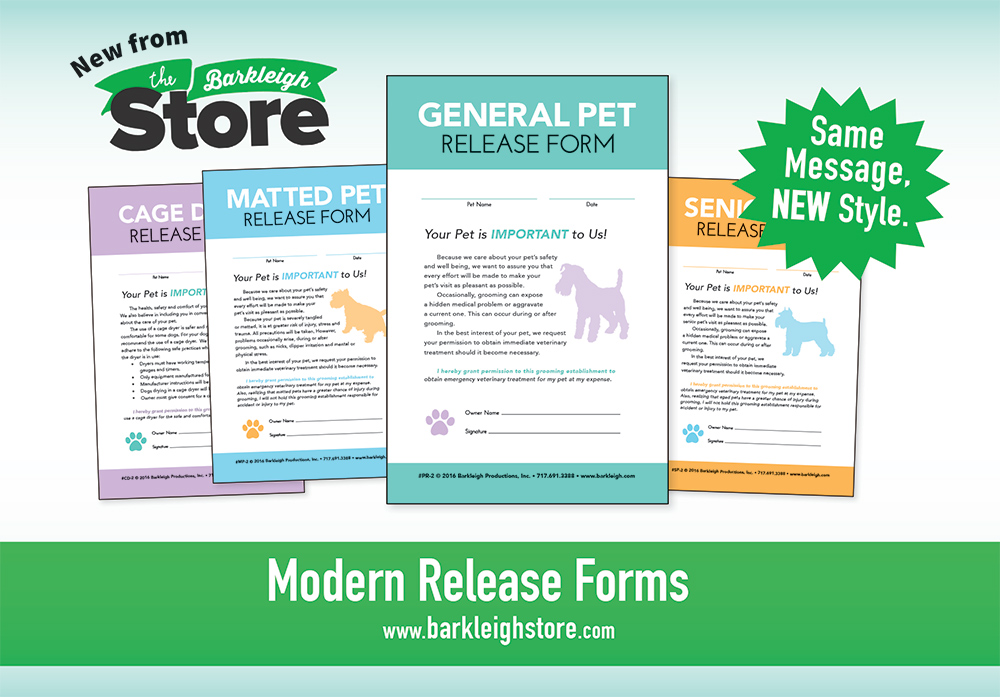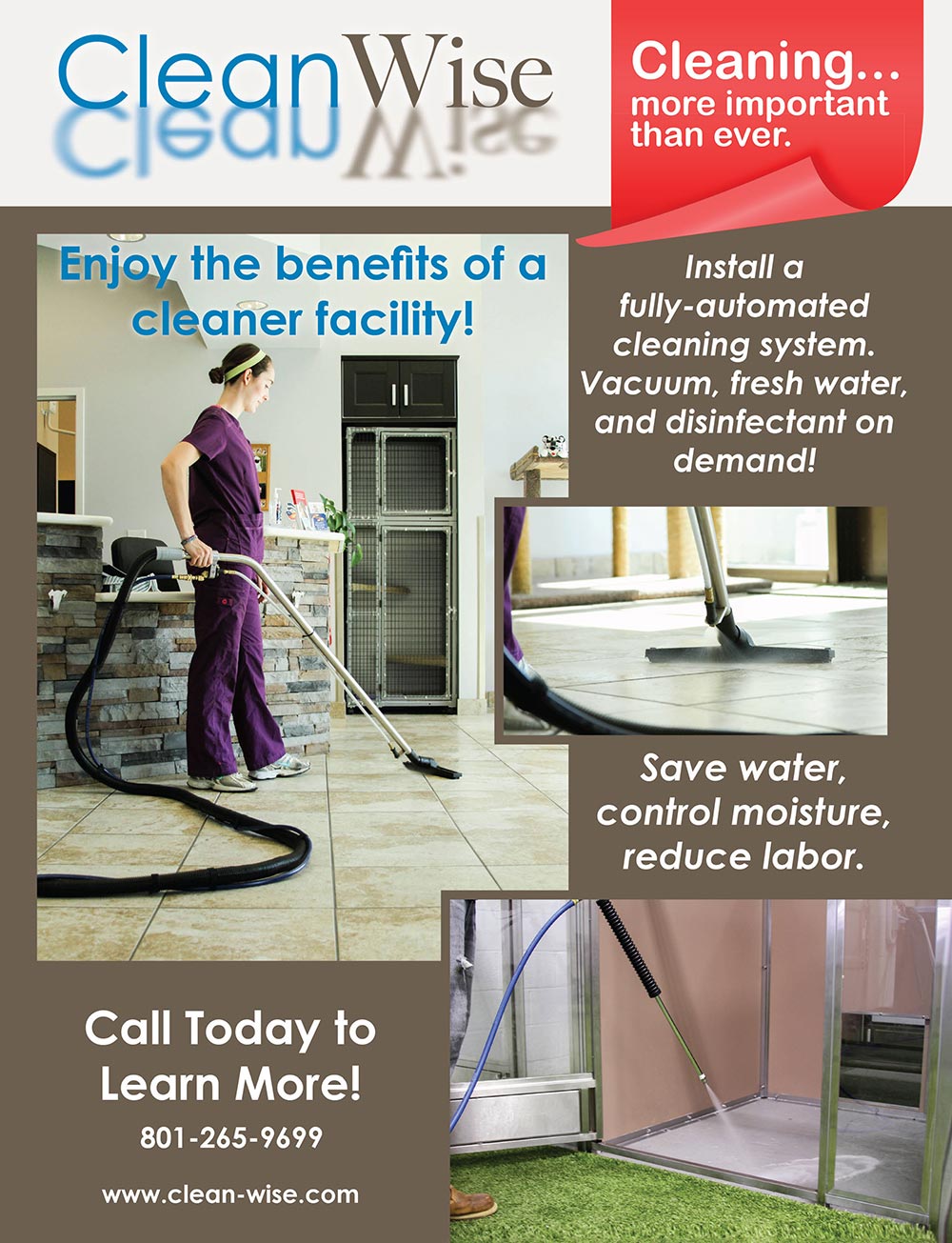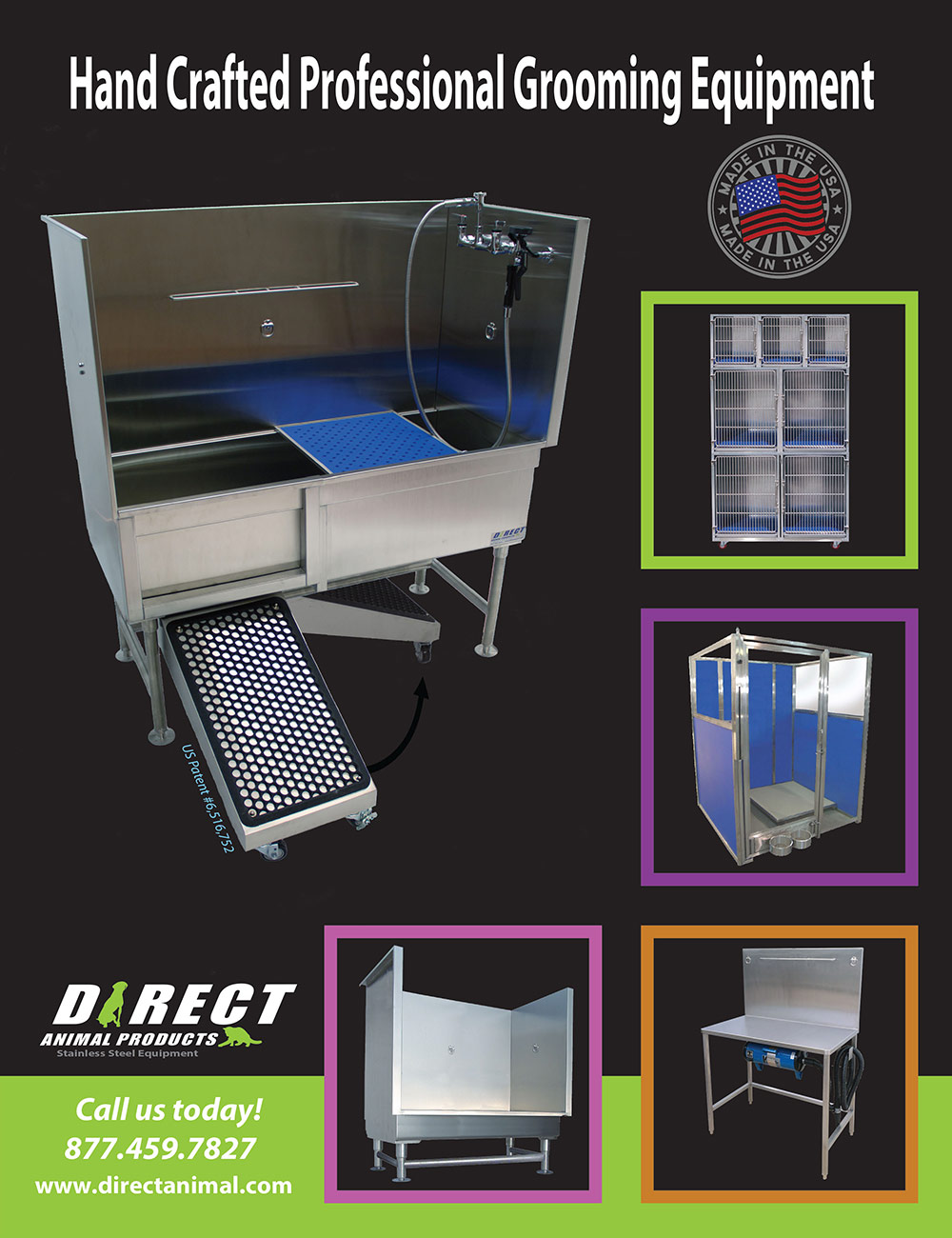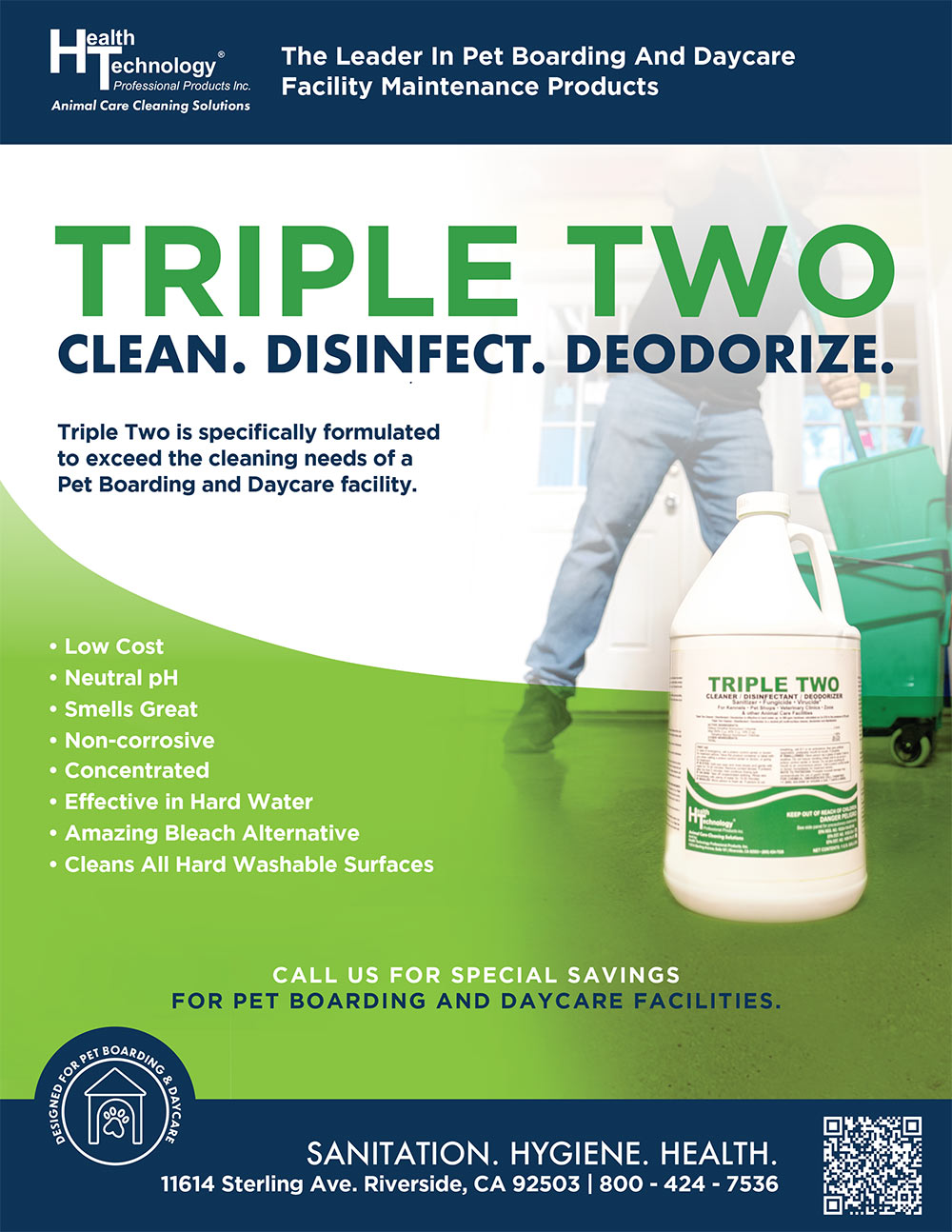Barkleigh Productions, Inc.
Rebecca Shipman
Laura Pennington
Brandi Aurelio
Carlee Kubistek
Luke Dumberth
Todd Shelly
Gwen Shelly
Adam Lohr
James Severs
Karin Grottola
Cassidy Ryman
Evan Gummo
CONTACT
General: (717) 691-3388
Editorial: rebecca@barkleigh.com
Advertising: james@barkleigh.com

it’s advertisers for their continued support.
- Aerapy Animal Health11
- Alpha Tech Pet26
- Barkleigh Store27
- Barkleigh Store52
- Best Shot Pet35
- Bio Ox37
- Black Diamond Radio7
- Blue2
- Business Insurers50
- Campbell Pet Company15
- Clean Wise54
- Destination Pet38
- Direct Animal Products55
- Dog Handler Academy29
- Dog Kennel Flooring24
- Electric Cleaner Company27
- First Financial Bank8
- Forever Lawn9
- Gyms For Dogs33
- Health Technology56
- HT Products14
- Kuranda Pro5
- Live Oak Bank49
- Natura Turf Pro44
- Online Doggy30
- Outstanding Pet Care19
- Paragon Pet School23
- Pet Biz Insurance36
- Pet Boarding Certification43
- Pet Business Marketing51
- Pet Butler13
- Pet Care Boot Camp20
- Pet Exec21
- Pet Lift45
- Pet Shield46
- Pet Vet Sales16
- Pet Vet Sales - Market Update25
- Phillip Paris Consultants41
- Poly Pet-Tubs32
- Presidio Kennels18
- Pro Edge24
- Puppy Playground31
- Shor-Line3
- Snyder Mfg. Co53
- Stone Mountain Pet Products40
- Turnkey10
- Uricide47
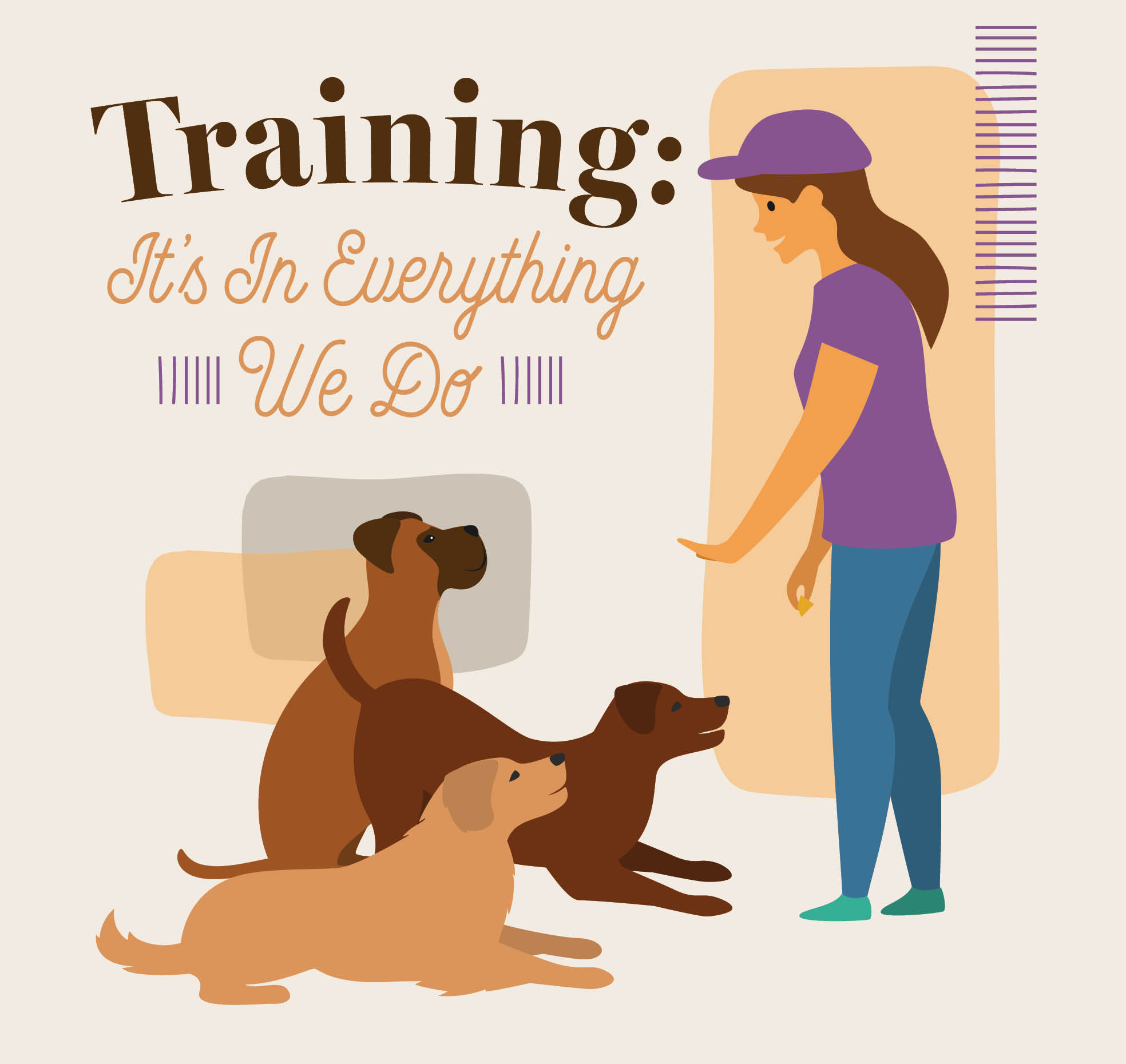
 n a dog daycare, we’re always working on training dogs. This training involves either encouraging good behavior or stopping unwanted behavior, like jumping or bolting out the gate. We’re all acting as dog trainers—some of us are just freelancing as dog handlers.
n a dog daycare, we’re always working on training dogs. This training involves either encouraging good behavior or stopping unwanted behavior, like jumping or bolting out the gate. We’re all acting as dog trainers—some of us are just freelancing as dog handlers.
One key thing to a successful dynamic in a dog daycare is consistent verbiage among the staff. This means that everyone uses the same words and commands. In addition to keeping it simple for your team members, it also helps the dogs understand what’s expected of them within your daycare environment—even if they only come to the daycare occasionally.
If one person uses “off,” another person uses “down,” another uses “no” and another uses “ahn-ahn,” eventually the dog will probably figure out what everyone means, but that takes too long. And in the process, your team members have likely gotten a bruise or a scratch from the dog jumping up on them. Instead, if we’re consistent with our verbiage, the dog learns much faster.
It may help to think of your dog training vocabulary like learning a foreign language—is it easy to learn that “no,” “stop,” “off” and “down” all mean the same thing? Or are you better off to have all your team members use “ahn-ahn” to tell the dog that means they need to stop what they’re doing regardless of the behavior? The more consistent that you and your team can be, the easier it is for the dogs to understand what you’re saying and create that memory loop.

When we’re trying to stop a behavior like jumping or play-biting, we can use treats, body language or our tone of voice. The way we speak to the dogs matters. Whether it’s a high-pitched, cheerful “Hi, Fluffy!” or a low-pitched, stern “ahn-ahn,” dogs pick up on our tone and that helps them understand what we want.

We aren’t just simply taking care of dogs—we’re helping to mold their future lives. Always consider how the dog feels about their behavior. Doing so will make sure dogs are happy and feel safe in our dog daycare.
Eve Molzhon is the creator and owner of Dog Handler Academy. Dog Handler Academy is a 100% online, automated employee training program designed specifically for dog daycares and boarding facilities. Our real-life daycare videos and online quizzes fast-track your new hires into understanding dog handling and care, saving you time and money. Courses cover basic and advanced dog handler skills, social cues and safety, client relations, and more. The mission of Dog Handler Academy is to provide employers training new hires with comprehensive material in a cost-efficient, consistent, and effective program. Our end goal is to create better handlers within our industry to ensure the proper care of animals.
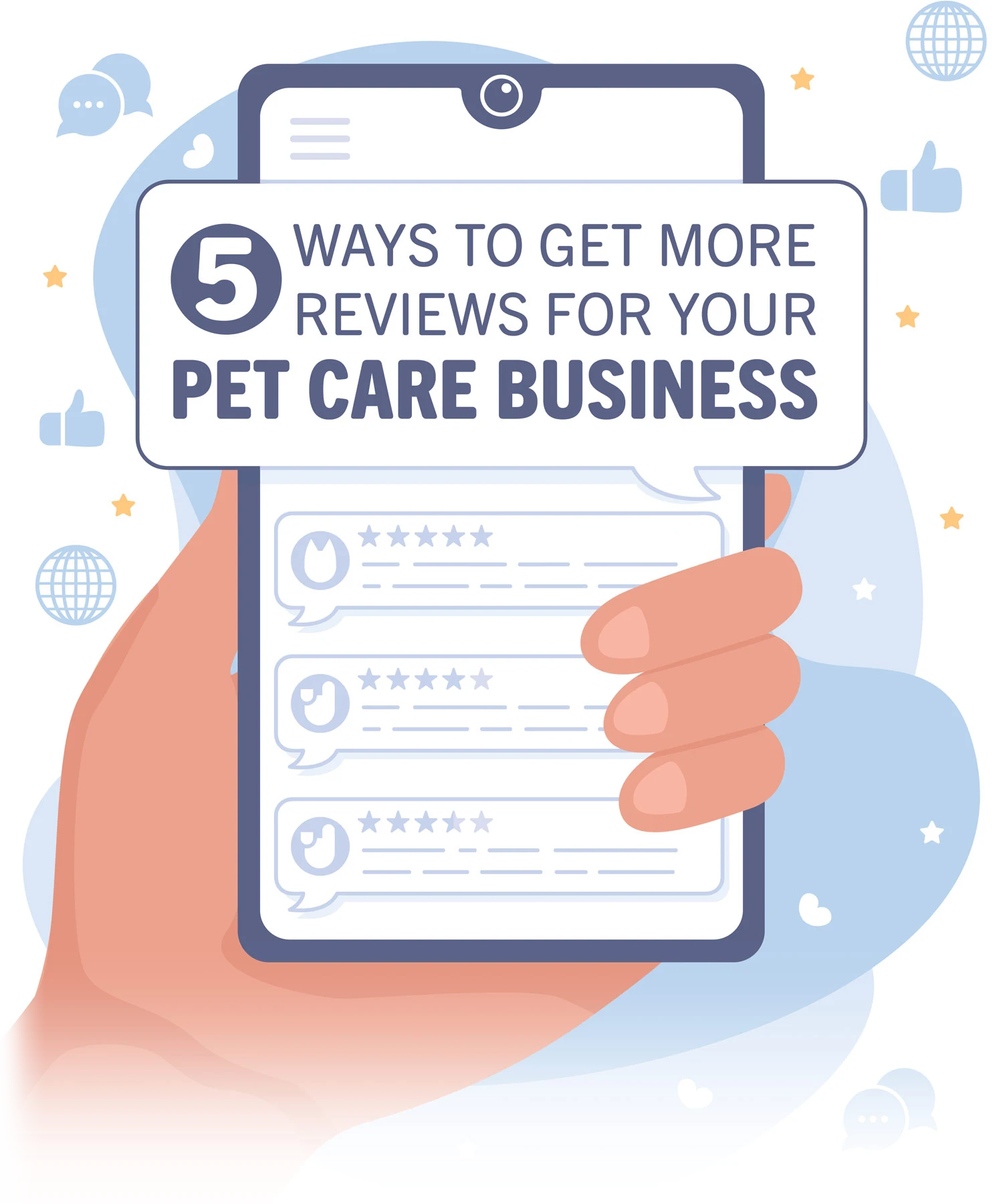
 ne key to a thriving pet care business is ensuring customers are satisfied, and that’s largely reflected in your online reviews. Prospective customers rely heavily on authentic feedback to make informed buying decisions. They want to feel confident in your services, and online reviews establish that trust.
ne key to a thriving pet care business is ensuring customers are satisfied, and that’s largely reflected in your online reviews. Prospective customers rely heavily on authentic feedback to make informed buying decisions. They want to feel confident in your services, and online reviews establish that trust.
An abundance of reviews also determines how high you rank in the Google searches that prospective customers use to find you. More reviews help you stand out among your competitors, especially since people are more likely to choose a business that has plenty of them.
Here are five ways to secure more reviews to boost your business’s reputation and gain more customers and their pets over time:

- Keeping owners in the loop about how their pet is doing
- Sending pet pictures throughout the day
- Maintaining a clean environment
- Making it easy to schedule drop-off and pick-up
- Providing plenty of activities for pets
Then you can ask pet parents for reviews as they come to pick up their pets. Handing them a card with instructions or having a QR code that goes directly to your reviews page makes it easy to do that. You can even offer a small discount on future services if they leave you a good review.

- Highlighting a pet of the week
- Showing off your facilities through videos or photos
- Spotlighting group photos of pets playing and socializing
- Sharing existing positive reviews and testimonials
People flock to social media to ask their friends and family for personal recommendations, and having an active social media presence helps increase your visibility—especially when people check out your page. Regularly posting and engaging with your audience will attract more attention to your services, which can subsequently lead to more positive experiences and reviews.
Make sure that you’re answering their questions, addressing any concerns and responding to every review that customers leave on your page. The more your audience sees you engaging and interacting with them, the more likely they are to leave you feedback, too.
Leveraging social proof is valuable for your page and shows that you value what customers have to say about your pet boarding or daycare business. It builds credibility, encourages others to share their thoughts, and even helps prospective customers make a buying decision.


- Having them text a keyword to your business number
- Putting an SMS Chat widget on your homepage, which customers can use to start text conversations with you
- Asking customers to agree to receive texts via your contact and registration forms
Keep your texts brief and straight to the point—you’re working with a smaller character count, and you need to touch on all key points within one text. Pre-made text templates are helpful here so you don’t have to draft a message each time you send a review request. Try sending a text like:
Hi [Customer]! We’d love it if you could write a Google review to share your experience with us: [URL] Thanks for choosing [Your Business]!
In addition, a dynamic business texting software with review management capabilities can help you connect with your customers and manage reviews all in the same place.

The combined customer bases and referrals from both sides contribute to a collective, shared experience for everyone that they’ll want to talk about. You’ll also have more people to help you ask for reviews. As a pet boarding or daycare business, aim to collaborate with similar businesses such as:
- Veterinary clinics
- Pet supply stores
- Dog trainers
- Pet photographers
- Local rescues and shelters
Showcasing each other’s services helps demonstrate your value to both sets of customers, which can positively influence how people perceive your business. By building your pet business community, you help each other grow, and cut down on costs along the way.
Pet owners have to go to different places for different services, but if you create a bubble where they can get everything done at once, it’s a win for everyone. For example, partnering with a local dog trainer gives you an opportunity to host training sessions at your facility while people’s pets are staying with you.
Collaborating helps grow your customer base, giving you exposure to new customers while building on your existing reputation with current customers. Creating memorable, positive experiences like this is key to earning more reviews.
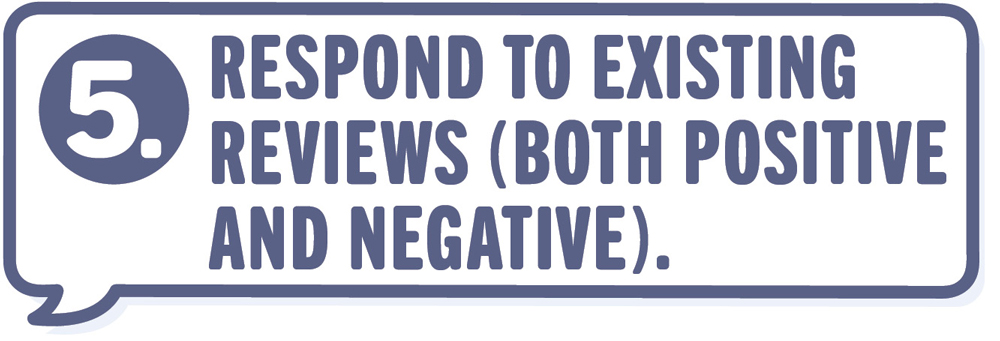
- Be empathetic and clear
- Express gratitude
- Use an appropriate tone
- Offer resolutions
- Note valid criticisms to further improve your services
Above everything, maintain a positive, professional decorum in your interactions. You’ll leave a lasting impression when customers see you’re focused on finding solutions. The more you monitor and respond to your reviews, the more customers will be encouraged to leave you feedback.
Jessica Ayre is a content marketing specialist at Text Request, a business texting solution. If your business wants to start texting with customers and earning high-quality reviews, Text Request can give you all the tools and resources you need to create a successful strategy. www.textrequest.com

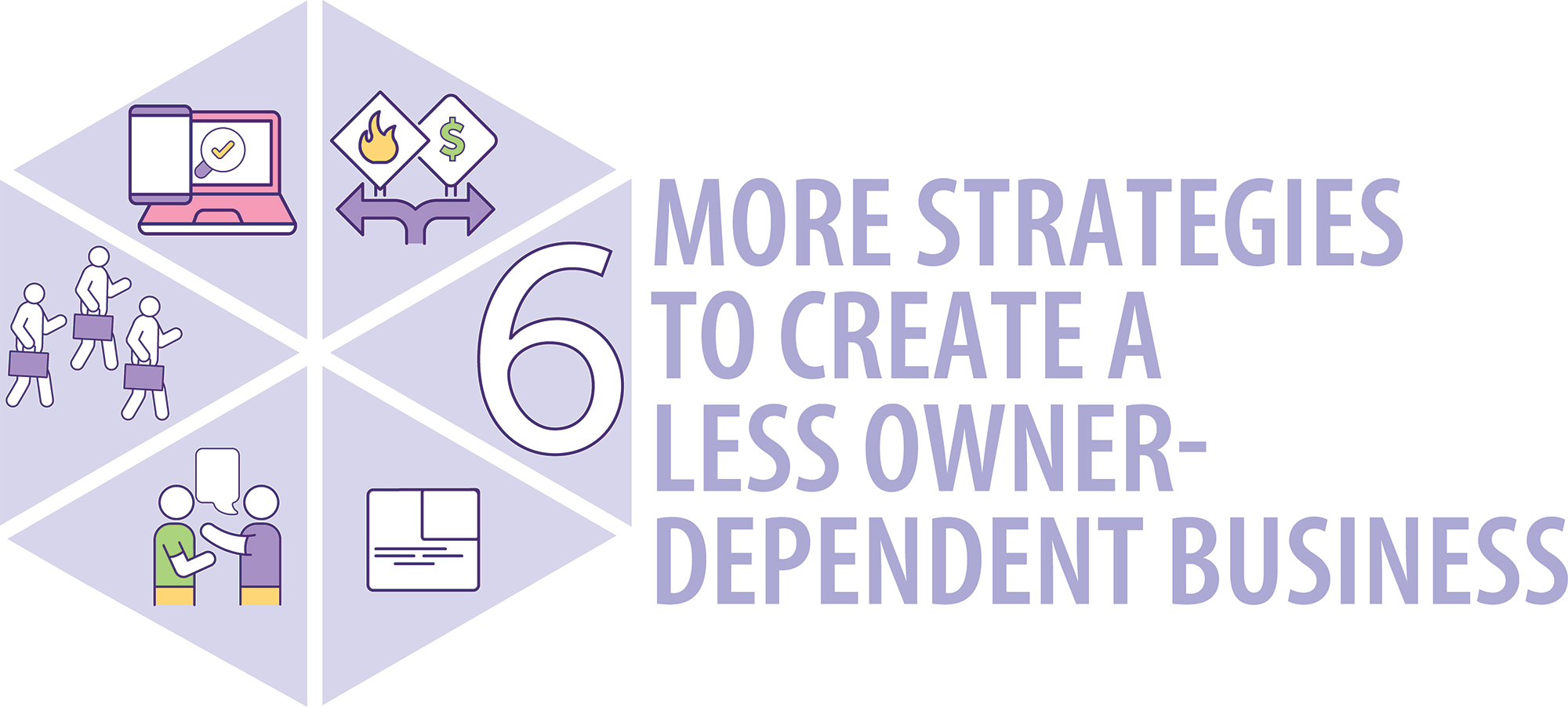

 ne of the most demanding and important times of year for the pet care industry is upon us—the winter holiday season. If you’re like many pet care business owners, you’ll find yourself swept up in the rush, working long hours at the facility every day just to keep operations running smoothly.
ne of the most demanding and important times of year for the pet care industry is upon us—the winter holiday season. If you’re like many pet care business owners, you’ll find yourself swept up in the rush, working long hours at the facility every day just to keep operations running smoothly.
Far from merry and bright, the holiday season often has many owners stressed, exhausted and run ragged—even more than usual. But imagine being able to enjoy the holidays to the fullest, spending time with family and enjoying relaxing downtime with peace of mind that your business is operating wonderfully in your absence. The good news is, this reality is within every owner’s grasp, and it can be achieved with effective development of your management team.
In a previous article, we outlined five powerful strategies to help accomplish this, which were:
1) Create and share advancement opportunities.
2) Utilize accurate and clear job descriptions.
3) Provide fair compensation and pay ranges.
4) Implement an effective onboarding process.
5) Provide a comprehensive operations manual.
In this article, we’ll go over six more impactful ways to foster a business that performs as well in the owner’s absence as it does in their presence.
Scheduling is often an area of what we call “key person dependence;” that is, only one or two people know how to create the schedule, making your business completely reliant on them for this important task. Frequently, scheduling falls on the owner or manager. It’s a time-consuming process with many moving parts, but there are ways to simplify schedule creation.
Scheduling software can help tremendously. The next step is to create clear rules and guidelines for the schedulers to follow. Ultimately, a simple and clear scheduling process means more employees can handle the task, taking another responsibility off the owner’s or manager’s shoulders.
Mistakes are a learning opportunity, and how you respond to infractions plays a significant role in employee performance and company culture. Ensuring the owner, managers and supervisors are positive with employees is key. This is tough to do when you’re running around like a chicken with your head cut off. Regardless, mistakes will happen. Having a well-defined disciplinary process ensures appropriate responses with consistent treatment. This is another key to setting your employees up for continued improvement and success.
Hiring can consume a lot of time, especially if the responsibility falls on the owner. Often the owner doesn’t have enough time or energy to do this well, which means you remain understaffed for longer, causing more stress on the owner and the staff. Establishing a robust recruiting process is an essential skillset for any business. Ultimately, managers, when properly trained, should be able to make most (if not all) hiring decisions, freeing up the owner for other tasks.
Many owners are thrilled to realize that their managers can often facilitate most building maintenance. A great first step is to have ongoing and active discussions about the state of the building and possible repairs. This allows you to more easily anticipate maintenance before it impacts business. Facility maintenance checklists can help when used by staff on a weekly or monthly basis.
Next, develop (or update) your approved vendor list to help keep everyone on the same page. For any large renovations or significant upgrades, the owner will still likely be closely involved, but most day-to-day maintenance and purchasing needs can be handled by managers.
Each of these strategies helps establish a capable management team to make the business more independent of its owner. While the owner will always play an important role, they can be freed from the daily minutiae, thus reducing stress and allowing more time to focus on bigger picture goals, like growing your business to its full potential!
Laura Laaman is president of Outstanding Pet Care. Outstanding Pet Care’s Management Development Program provides the tools you need to implement these strategies successfully. If you’re interested in a healthier and more rewarding business, schedule a consultation by calling 1-888-836-8740 or visiting www.outstandingpetcare.com/contact
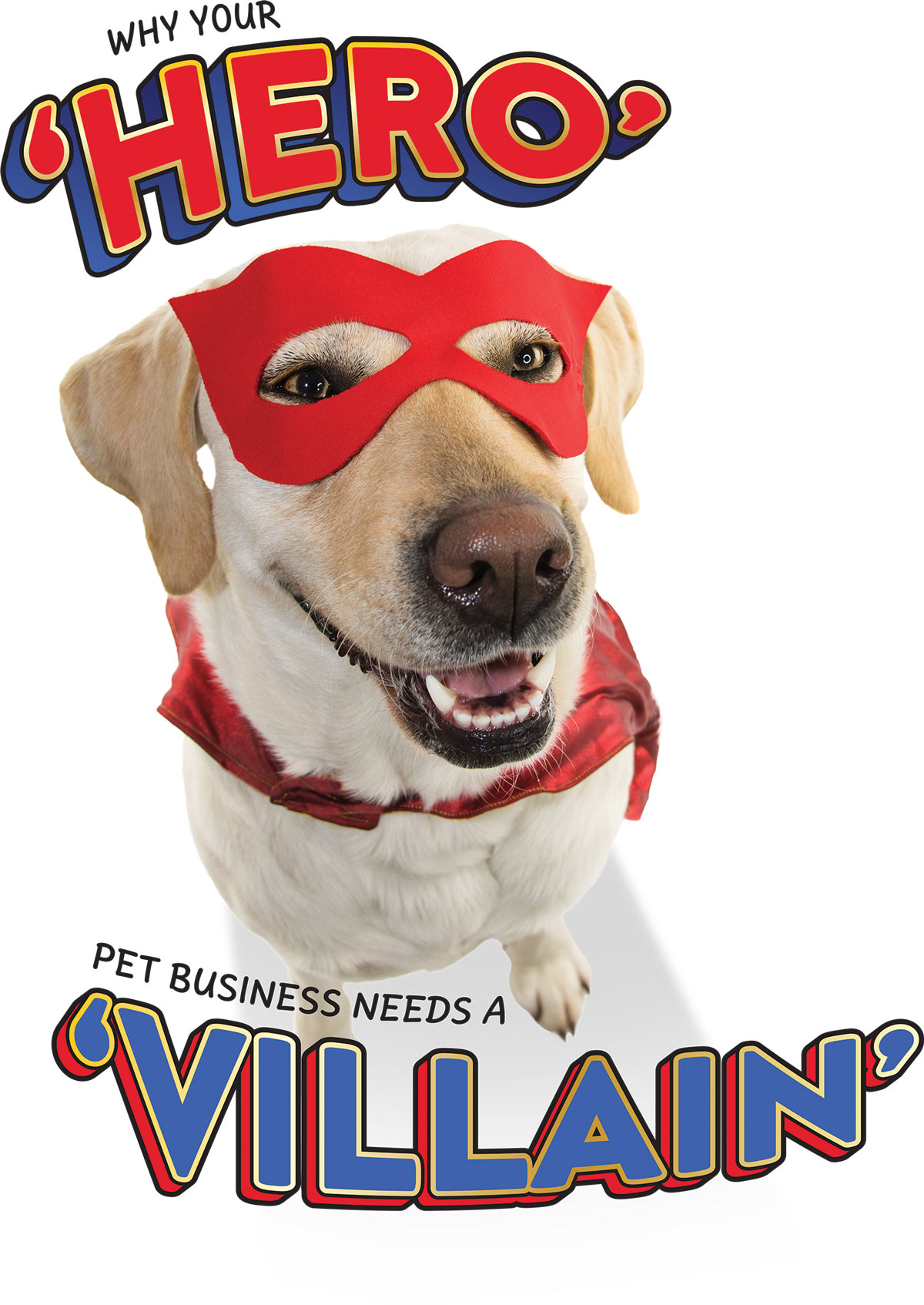
 f I asked you to name the baddest Disney villain, who would you choose? Murderous Maleficent from Sleeping Beauty? Power-hungry Scar from The Lion King? Dog thief Cruella de Vil from 101 Dalmatians? My own personal favorite is probably Madame Medusa from The Rescuers.
f I asked you to name the baddest Disney villain, who would you choose? Murderous Maleficent from Sleeping Beauty? Power-hungry Scar from The Lion King? Dog thief Cruella de Vil from 101 Dalmatians? My own personal favorite is probably Madame Medusa from The Rescuers.
It’s interesting that although Disney films are aimed at little children, they sure are packed with horror, evil, treachery, betrayal and even death! But there’s a very good reason these gruesome guys and gals are pure devils…
In any kind of storytelling, the villain is just as important as the good guy. In fact, in many ways the villain is more important. Think about it: Would you have cared as much for Luke Skywalker if Darth Vader wasn’t his dad? Even in professional wrestling, every major superstar good guy needs a similarly major badass enemy, or “heel,” as it’s known in the trade.
The same applies when you are marketing your pet services. You need a “villain” of the piece. You need to identify some terrible outcome that dog owners in your town are suffering from that only your service can thwart. And in your marketing, you need to highlight this huge agony-inflicting ache that keeps your prospects awake at night, and then position your superpower service as the solution.
Sound familiar?
Now, if you were running a pet business 30 or 40 years ago when there wasn’t a lot of competition around, then that kind of advertising might be OK. Or, if someone needs a doggy daycare and you are the only choice in your town, then it’s fine to have an advertisement that says, “We are a doggy daycare.”

One way to protect your pet business, or supercharge the growth of a new business, is to master how to market your services by using compelling copy that converts. Don’t market your business by only talking about the positive or obvious aspects of your service. You need to put your prospects’ pain points (or the “villain” of the piece) front and center with your marketing. Your marketing simply won’t work as well without a villain, just like Disney movies wouldn’t work without a villain…
Without a villain, the story of Beauty and the Beast would read: Avid reader from French village meets grumpy outcast and falls in love. Or, without a villain, The Jungle Book would read: Lost boy lives happily ever after in jungle with animal friends. Which would be incredibly boring, right? And, that’s what your advertisements look like without a villain.
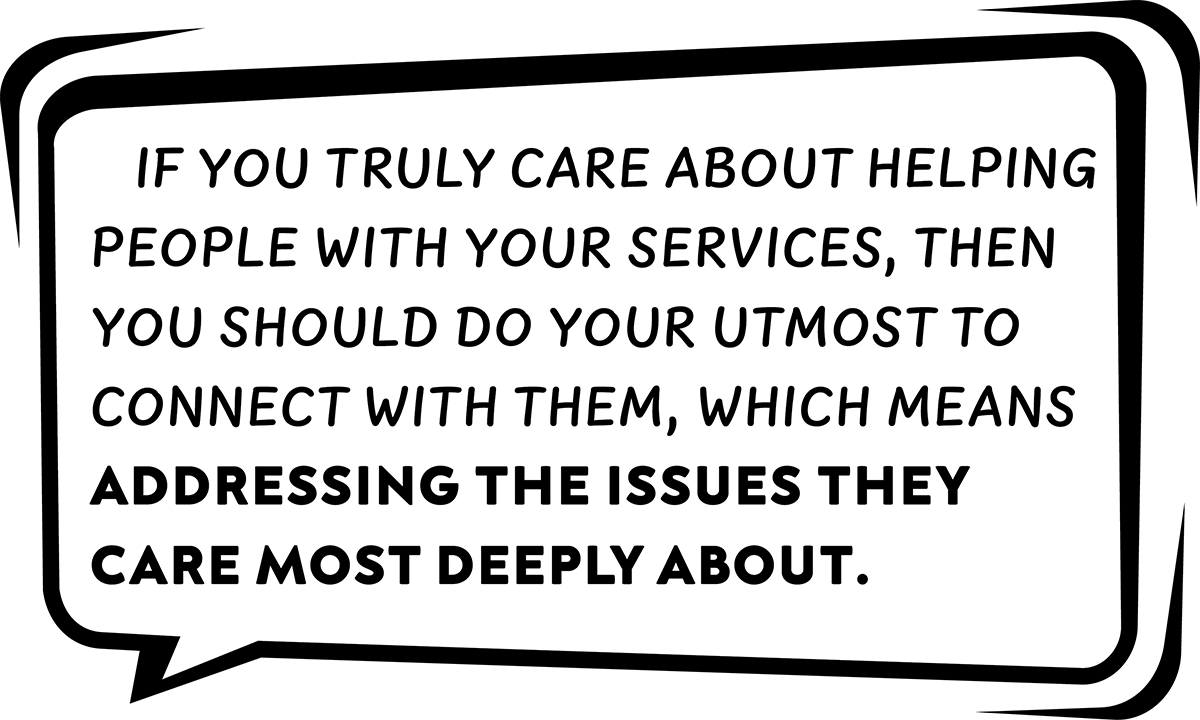
Dog owners who have jobs feel guilty about leaving their dogs home alone. They leave the television on, spend any amount of money on fluffy toys for the dogs to play with and then can’t concentrate when they are at work because they are worried about the dog. Or, leading up to a vacation, dog owners stress themselves out about leaving their dog with a boarding establishment they can trust. So, speaking to them about their fears and concerns in your marketing will position you as a business who cares and understands.
Don’t think of it as seedy or immoral to talk about prospects’ pain points. If you truly care about helping people with your services, then you should do your utmost to connect with them, which means addressing the issues they care most deeply about.
Part of it comes down to a lack of awareness that your service exists, and the other part is a lack of trust in your ability to help them.
Starting with the pain points has three BIG advantages:
 Draws attention. Just like when training a dog, the first thing you need is your prospect’s attention, and using pain points gets attention. Problems have always been a big deal for us humans because we notice them. Just like the caveman used to be wary when he heard a rustling in the bushes, because that could have represented a life-threatening problem such as a sabre-toothed tiger who wanted to eat him, dog owners in your town have problems too. And you’ll get their attention by talking about them in your marketing.
Draws attention. Just like when training a dog, the first thing you need is your prospect’s attention, and using pain points gets attention. Problems have always been a big deal for us humans because we notice them. Just like the caveman used to be wary when he heard a rustling in the bushes, because that could have represented a life-threatening problem such as a sabre-toothed tiger who wanted to eat him, dog owners in your town have problems too. And you’ll get their attention by talking about them in your marketing.
 Builds trust. The second advantage to leading with pain points in your advertising is that it builds an immediate level of trust between you and the prospect. It doesn’t mean they will necessarily buy your service straight away, but they will be more inclined to read the rest of the ad and copy, down your contact details, because you demonstrate you understand the problems they are suffering from. This is very different from the kind of ads your competitors are doing. Consequently, it’ll make yours stand out.
Builds trust. The second advantage to leading with pain points in your advertising is that it builds an immediate level of trust between you and the prospect. It doesn’t mean they will necessarily buy your service straight away, but they will be more inclined to read the rest of the ad and copy, down your contact details, because you demonstrate you understand the problems they are suffering from. This is very different from the kind of ads your competitors are doing. Consequently, it’ll make yours stand out.
 Creates urgency. With any kind of ad we put out there, we want the reader to take some kind of action. Either to move towards investing in our services or, if not, then to certainly move closer towards buying. Well, when we use pain points, we remind the dog owner of the problem that is causing them a lot of stress, anxiety and worry. Then, if you can position your service as the antidote to the poison, you’ll cause the prospect to take action faster.
Creates urgency. With any kind of ad we put out there, we want the reader to take some kind of action. Either to move towards investing in our services or, if not, then to certainly move closer towards buying. Well, when we use pain points, we remind the dog owner of the problem that is causing them a lot of stress, anxiety and worry. Then, if you can position your service as the antidote to the poison, you’ll cause the prospect to take action faster.
Framing your prospects’ big problems as the villain and your amazing service as the hero will transform how effective your pet business marketing is. Start by sending out a simple survey asking your clients what their biggest worry, struggle or challenge was before they started using your services. That will give you the material you need to write copy for your new, attention-grabbing, pain-point-focused advertising!
Dom Hodgson is Europe’s leading pet business coach, and is known as the Pet Biz Wiz. His mission is to help pet service providers create superior customer service systems that enable them to build an impactful and profitable pet business. Dom has written over nine books, and is a much in-demand speaker. You can instantly download a free copy of his latest book “How to Disnify Your Doggy Daycare Business” by going to www.petbusinessmarketing.com/daycaremagic
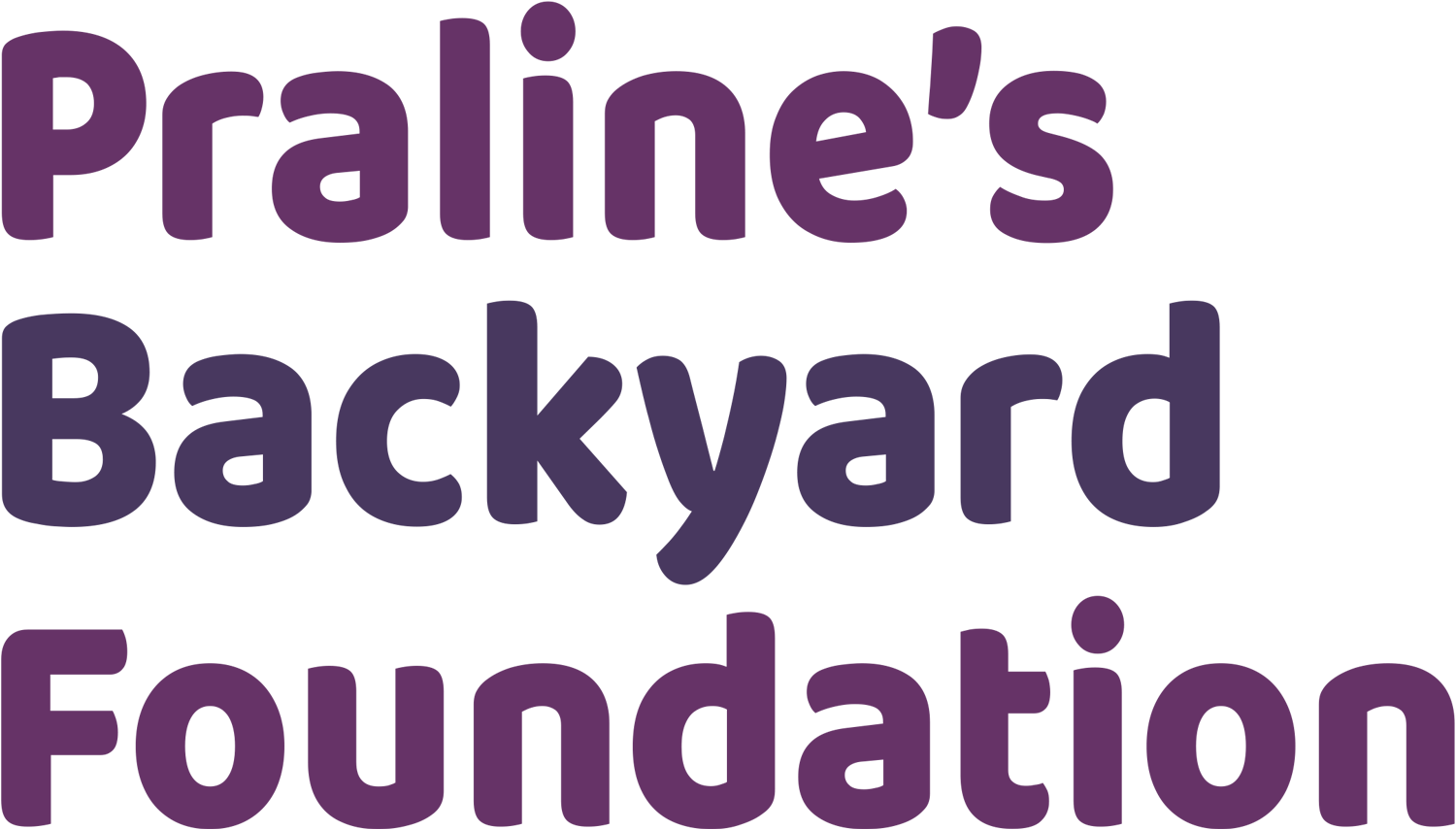


Photos provided by Praline’s Backyard Foundation
 he statistics are staggering. Ten million people experience domestic violence each year in this country, and these are just the documented cases. The actual number is likely much, much higher,” says Orazie Cook, DrPH, MPH, MIAD.
he statistics are staggering. Ten million people experience domestic violence each year in this country, and these are just the documented cases. The actual number is likely much, much higher,” says Orazie Cook, DrPH, MPH, MIAD.
For more than 20 years, Orazie has worked for hotlines and volunteered at domestic violence shelters and humane societies, and she has seen firsthand the obstacles that these survivors face. Time and time again, Orazie found that domestic violence survivors (of which the vast majority are women) found it difficult to leave an unhealthy living situation when the welfare of their pets was involved.
It’s been reported that as many as 48% of survivors delay leaving a dangerous situation out of concern for their pet’s safety. And Orazie has seen some make the heartbreaking decision to relinquish their pets to a local shelter rather than leave them with an abuser, but didn’t have the resources to make a change. However, when Orazie founded Praline’s Backyard Foundation, named after her own dog, Praline Pecan, her unique approach to this problem began changing lives all across our nation.



Praline’s Backyard Foundation, a 501c3 nonprofit, was created to provide temporary free boarding or foster care for the pets of domestic violence survivors during times of crisis.
Praline’s Backyard Foundation, a 501c3 nonprofit, was created to provide temporary free boarding or foster care for the pets of domestic violence survivors during times of crisis.
“Our work revolves around breaking the cycle of violence by offering survivors a safe haven for their beloved companions while they seek safety and healing as they transition to safe housing,” says Orazie. “We believe that pets play a crucial role in the healing process for survivors; offering comfort, companionship, and unconditional love during a difficult time.
“We firmly believe that no one should have to choose between their own well-being and that of their pets,” she continues. “I don’t want any survivor to return to an abuser over concern for the safety of their pet.”

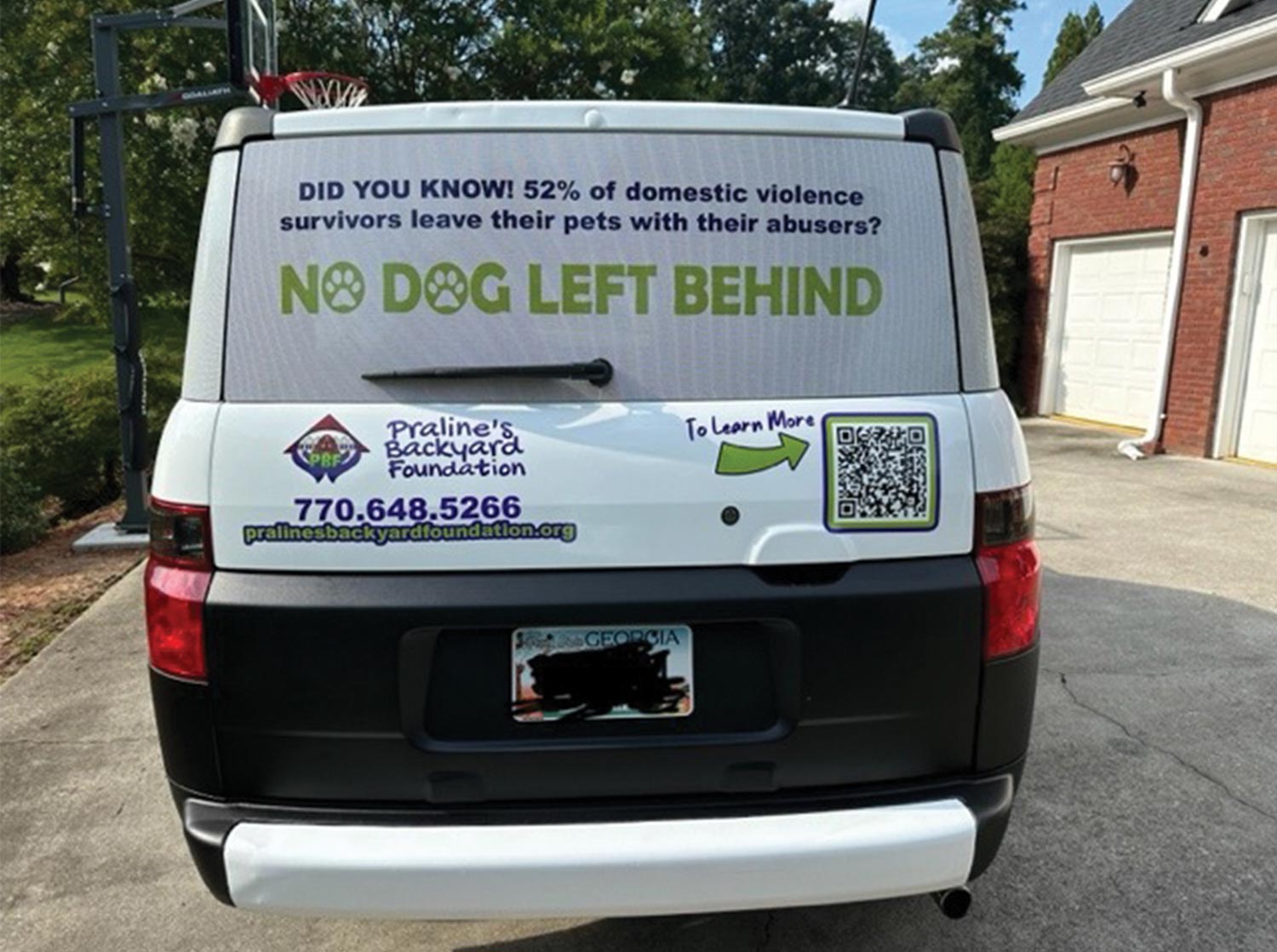
Less than 30% of diomestic violence shelters are pet friendly. Now, Praline’s Backyard Foundation helps fill that enormous need.
The need for temporary pet housing and care is great. Less than 30% of domestic violence shelters are pet friendly. Now, Praline’s Backyard Foundation helps fill that enormous need. When a survivor wants to leave an abuser and they know they have somewhere to place their pet temporarily, it allows them to go forward with that life-changing decision.
Praline’s Backyard Foundation is listed with the National Domestic Violence Hotline and a number of other organizations throughout the country. Every domestic violence shelter in the U.S. has received a letter from Orazie explaining what Praline’s Backyard Foundation does, the services they provide, their contact information and how they support survivors.

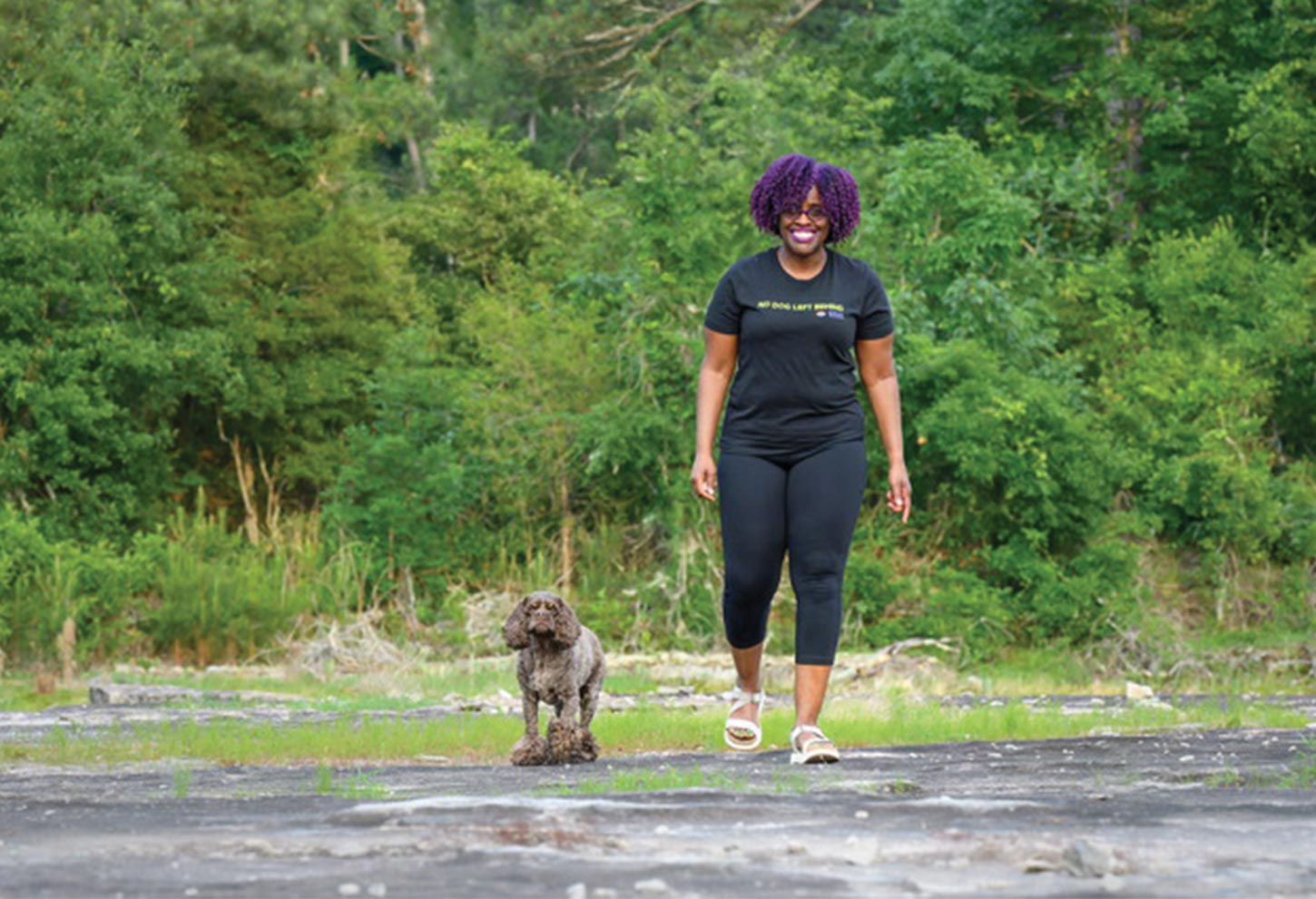
“We don’t do this alone,” says Orazie. “Our approach is unique, with far-reaching results. Instead of building a brick-and-mortar facility which could only help people in a limited area, we collaborate with a vast network of existing pet boarding facilities and individual pet fosters across the nation to give immediate support to domestic violence survivors. It’s an ideal partnership because these facilities already exist and care for the animals.
“Instead of building a brick-and-mortar facility which could only help people in a limited area, we collaborate with a vast network of existing pet boarding facilities and individual pet fosters across the nation to give immediate support to domestic violence survivors.”
– Orazie Cook, founder of Praline’s Backyard Foundation
“The housing for pets provided through our foundation is free to the survivor,” she continues. “Our partnering pet boarding facilities often offer us discounted or complimentary services. This generosity enables us to allocate funds to assist survivors in areas where affordable pet boarding isn’t available. By opening their hearts, homes, and businesses to temporarily house pets of domestic violence survivors, our partners become beacons of hope and healing. Together, we ensure that no pet is left behind during the crucial moments of crisis and transition.”
“When you partner with Praline’s Backyard Foundation, you’re not just providing shelter and care for a pet in need, you are also helping to support a survivor as they recover and get their life back on track.”
– Orazie Cook, founder of Praline’s Backyard Foundation
The foundation has recently partnered with Doobert (www.doobert.com) which supports humane societies and other non-profits and groups that provide temporary housing for pets. Doobert also has an extensive network of fosters and pet care facilities which assists Praline’s Backyard Foundation in matching pets in need of shelter.
There is a form on the Praline’s Backyard Foundation website, www.pralinesbackyardfoundation.org, for survivors to fill out if they need help in getting temporary housing for their pet. As soon as they submit it, it goes into the Doobert system and alerts Orazie. It automatically generates a list of facilities and fosters in the survivor’s area that Orazie can contact to see if they have space available to house the pet.
Finding immediate housing and care for these pets is a critical part of helping the survivors and is making a huge difference in the epidemic of domestic violence. The process is becoming more streamlined as the foundation expands their network and partners with other organizations that are supportive of fostering and housing animals of survivors.
“When you partner with Praline’s Backyard Foundation, you’re not just providing shelter and care for a pet in need, you are also helping to support a survivor as they recover and get their life back on track,” Orazie shares.
“We are not just an organization, we are a movement,” she continues. “A movement that envisions a world where survivors are empowered, pets are protected, and no one has to make an impossible choice. Join us on this journey, and together, we’ll create lasting change—one domestic violence survivor and one pet at a time.”
To partner with them in this vital mission, visit www.PralinesBackyardFoundation.org and click on the “Join Our Network” button to fill out the online form.

 believe with any profit center—lodging, daycare, grooming or training—you should design for operations, and not let your design dictate how you and your team will operate. If a design creates headaches for your staff, not only will you be living with those issues for years to come, but it will also affect the cost of labor and, therefore, your profit margin. When planning your new training space or repurposing areas for training in an existing footprint, begin by outlining and defining your vision for the service.
believe with any profit center—lodging, daycare, grooming or training—you should design for operations, and not let your design dictate how you and your team will operate. If a design creates headaches for your staff, not only will you be living with those issues for years to come, but it will also affect the cost of labor and, therefore, your profit margin. When planning your new training space or repurposing areas for training in an existing footprint, begin by outlining and defining your vision for the service.Once you determine the type or types of training you’re going to offer, you should determine the desired class sizes and calculate the room needed. For example, puppy classes will require a small and private space for each pet and the trainer; but with group classes, you need space for a certain number of pets and a trainer, and so on. For daycare, as a general rule of thumb, planning for 75 sq. ft. per attendee sets the team and the group up for success. In a group training environment, however, you should double that, or more.
Generally speaking, those who are in group training sessions don’t have huge behavioral issues with their dogs and are attending class to strengthen their bond with their pet while working on core obedience cues. It’s not the dog at the end of the leash we need to plan for—it is the owner at the controlling end. Pet parents aren’t skilled or trained in body language like your daycare staff members are. They will need to have ample room to make and correct mistakes without stepping on the toes of other participants.

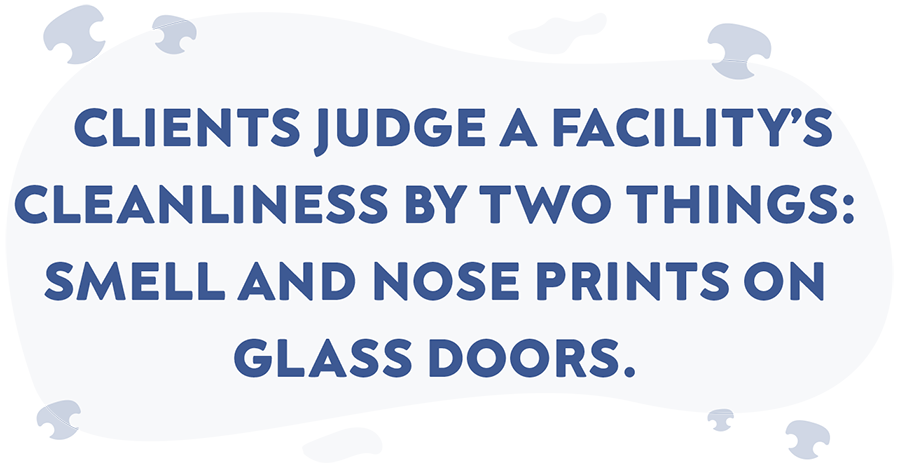
The resort or daycare environment can be the most exciting place for some pets. But for other pets, not so much. The excitement of playing with friends can be stressful, which reduces the dog’s ability to learn and retain information. This is true for their human counterparts as well. That constant high-pitched bark in the background, or even the cute fluff-ball of a puppy in the room, will distract both dog and handler.
So how can you adjust your design to help reduce stress in training environments? By controlling smells, reducing noises, utilizing visual blockers, building in pods or separate sections within the facility and planning transition spaces for milestones are all effective ways.
Noise reduction, visual blockers and built-in pods all reduce stress, thus increasing engagement. Depending on your vision, you may want full isolation areas that completely block off the vision and noise of other dogs in the facility. A reactive dog (or any dog, for that matter) is less likely to bark if they don’t see the distraction. Pony walls, solid enclosure fronts and even curtains reduce visual reactivity.
The first area that a new training client walks through should be quiet and without distractions. If they need to walk through lodging areas, make sure those areas in their path house dogs that are calm, quiet and non-reactive. This will not only help maintain the dog’s attention by not shocking them with loud noises and distractions, but will also set the handler up for success. As the dog and client become more skilled and confident, you can increase distractions by moving sessions further into the facility. Controlled distractions are your friend. We want them to engage and learn.
By outlining your vision, creating barriers and selecting the right finishes for the space, you will increase engagement, strengthen both client and dog retention, and boost satisfaction well before the first nail is hammered on your project.
Al Locker, Jr. is President of Turnkey, Inc., located in Houston, Texas. Turnkey, celebrating its 62nd year of operation, is a commercial design & design/build construction firm specializing in owner-occupied, special-use businesses, such as pet resorts and veterinary clinics. Turnkey’s design work starts with a full understanding of the project and the owner’s business plan needs, and all design work is done in-house. They provide the expertise to advise, design, and build the highest-quality project at the most affordable and feasible prices!
 ecently, a member of my coaching program group reached out to me because she had promoted an offer in her boarding and daycare business and she only got one sale, totaling $800. After learning what she offered and how she structured it, I recommended a few changes. She immediately went to work and crafted a new offer based on what we discussed, and the results blew my mind. When all was said and done, the new offer brought in over $40,000.
ecently, a member of my coaching program group reached out to me because she had promoted an offer in her boarding and daycare business and she only got one sale, totaling $800. After learning what she offered and how she structured it, I recommended a few changes. She immediately went to work and crafted a new offer based on what we discussed, and the results blew my mind. When all was said and done, the new offer brought in over $40,000.
Yes, you read that right—over $40K from a single offer.
Let me share with you some of the tips that I offered which made this amazing transformation possible, and that can help you get the most of out of a one-time offer in you boarding or daycare business:







Fern is the founder of Overdog Digital, a digital marketing & consulting agency that helps dog daycare and boarding facilities attract, convert, and keep more customers by creating winning marketing campaigns and providing the business guidance to build momentum and spark long-term growth. Fern also has programs to train daycare staff, is a dog behavior consultant, and has a dog training business in New Jersey. He is the author of eight books and a popular speaker at national conferences and private events. To join The Dog Daycare Business Think Tank or ask a question, go to: www.facebook.com/groupsdogdaycarethinktank
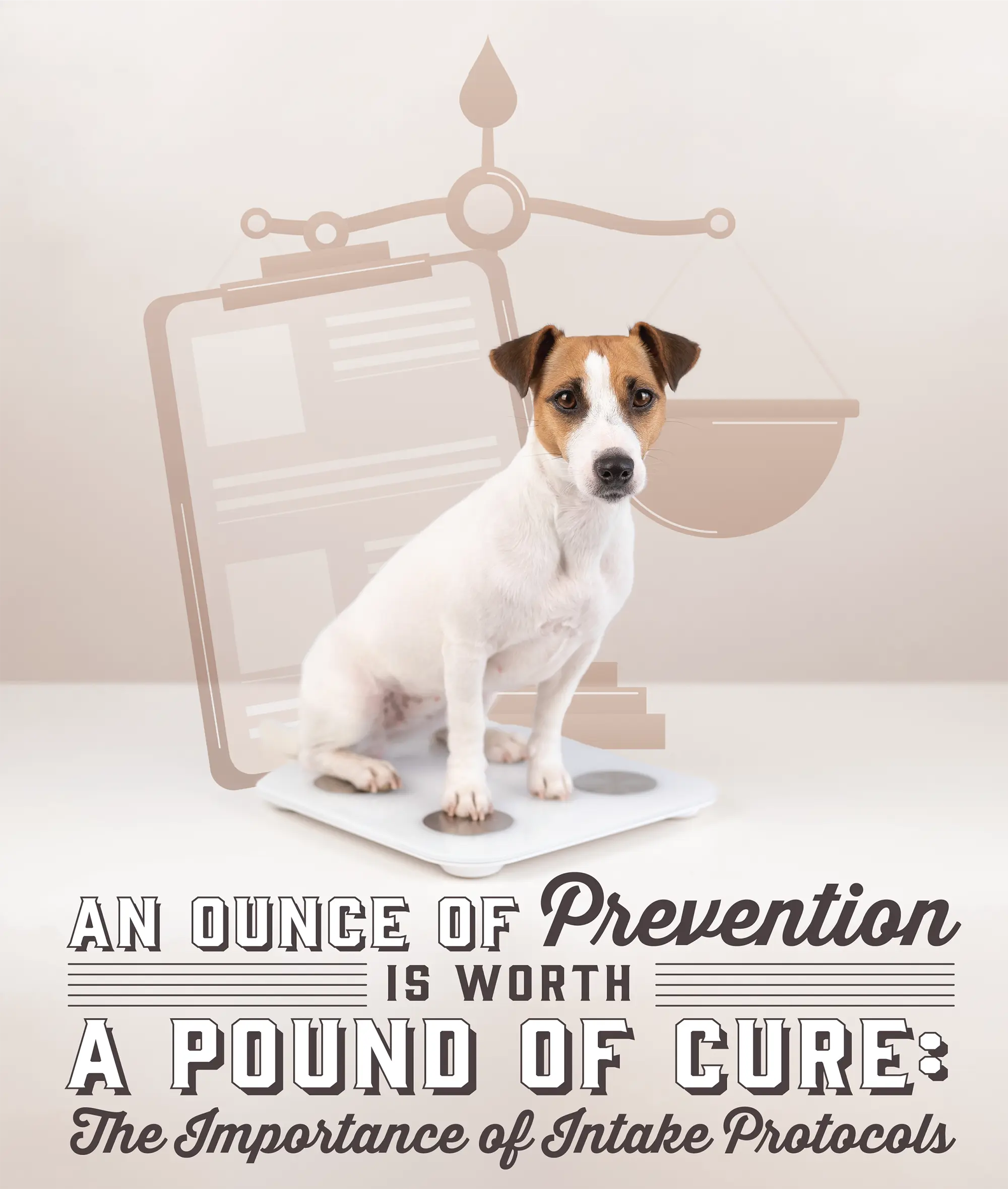
 very year, multiple times a year, the news media will carry headlines like, “Is there an outbreak of pneumonia in dogs? Here’s what you and your pup should know,” or “Respiratory disease outbreak: New Hampshire and neighboring states,” striking fear into pet care facility operators and pet owners alike. It seems like disease outbreaks are an inevitable part of operating any pet care facility…but are they?
very year, multiple times a year, the news media will carry headlines like, “Is there an outbreak of pneumonia in dogs? Here’s what you and your pup should know,” or “Respiratory disease outbreak: New Hampshire and neighboring states,” striking fear into pet care facility operators and pet owners alike. It seems like disease outbreaks are an inevitable part of operating any pet care facility…but are they?
Luckily, there are concrete steps that facilities can take to decrease the likelihood of an outbreak among their pet population. And in the world of infectious diseases, a single ounce of prevention may be worth even more than a pound of cure. Establishing solid intake protocols, strictly adhering to those intake protocols, consistently reinforcing staff training and maintaining effective communication are all key to any pet care facility preserving the health of their clients’ pets.
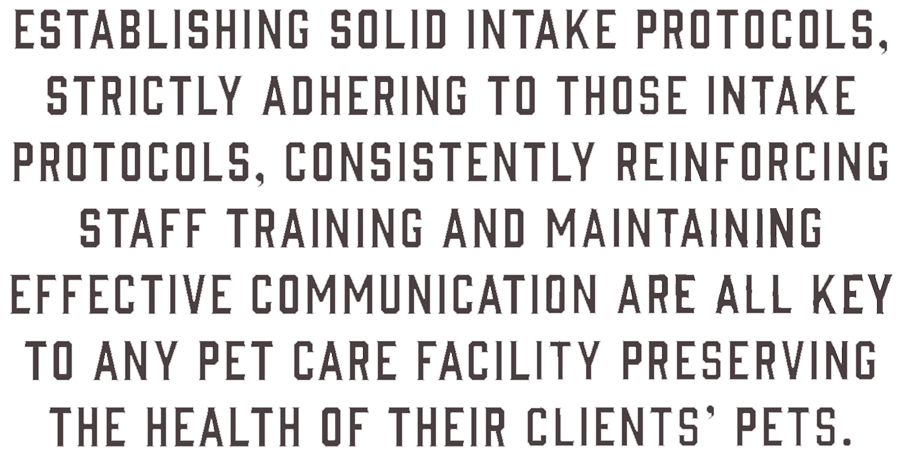
Any intake protocol is only as good as the enforcement of the requirements. Just as the personnel at the reception desk are the face of a facility, they are the frontline of defense against pathogen introduction to any facility by virtue of intake requirement enforcement. However, pet care is a customer service industry, so telling a dedicated pet owner that their pet is unable to enter a facility is, at the very least, a sticky wicket. It is imperative that intake/reception staff truly understand the importance of adhering to the intake protocols and requirements—regardless of the circumstances described by pet owners desperate to drop off their furry friend.
In fact, a facility is charged with safe-guarding the health and well-being of ALL the animals in their care, not just the single pet whose owner is begging them to make an exception…just this once. So, how can facility operators support staff in their effort to provide consistently high-level care to pets in the facility? With consistent and persistent staff training, of course!


Once your facility has worked with credible experts to create preventive protocols, establish staff training schedules to successfully implement the protocols and communicate the reason for the requirements to your clients, the fear of disease outbreaks can ratchet down a bit. Trust that preventive medicine is a pathway to disease prevention within your pet care facility.
Dr. Jenifer Chatfield is a double board-certified veterinary specialist in infectious disease and a world-renowned speaker at pet care conferences. “Dr. Jen the Vet” loves talking with pet lovers and pet care facility personnel about how to keep pets safe and healthy. If you are interested in adding Dr. Jen to your pet care facility team, check out her “Healthy Pet-Keeping Seal” program and enroll your facility today! More info is available on her website, drjenthevet.com, or by emailing GetTheSeal@drjenthevet.com


 t’s no secret that more and more cat parents are realizing that cats are social beings. They need attention and enrichment just like dogs. For some cats, spending an entire week or weekend by themselves is a lonely affair. They miss their people, just like dogs. As boarding and daycare professionals, these kinds of cats provide a great opportunity for you to expand your business and provide a social kitty the care and attention it needs.
t’s no secret that more and more cat parents are realizing that cats are social beings. They need attention and enrichment just like dogs. For some cats, spending an entire week or weekend by themselves is a lonely affair. They miss their people, just like dogs. As boarding and daycare professionals, these kinds of cats provide a great opportunity for you to expand your business and provide a social kitty the care and attention it needs.
But with cats being cats, what can you do to make a feline’s stay a positive experience for both the pet owner and the kitty? Carrie Seay, owner of Carrie Pawpins Cat Behavior Consulting Services in Phoenix, AZ, says you should ask a series of questions to make sure it’s a win-win for everyone involved.
Personality questions are the most important, as cats are typically more stressed than dogs in new situations. Other questions related to daily living are a must as well. Some examples are:

- Is your cat fearful, shy or have anxiety issues?
- How does your cat react to going to the vet?
- Is your cat able to be handled?
- What toys do they like? Feathered? Catnip? On a stick?
Seay says that when you board a cat, it’s really important to try to understand their personality and their quirks before they arrive. You want to make them feel as comfortable as possible. Behavioral quirks such as how they eat and drink can affect a feline client. “Ask the pet parent if their cat drinks out of a bowl with standing water, or out of a fountain. If you don’t know that, that can affect the animal when it comes to dehydration. It’s important to get it right,” she adds.
So how can you help a cat to relax once they’re in your care? “Make sure the cat owner brings things from home to help calm them. Perhaps a piece of clothing from the human so the cat can sniff their scent. Or, have them bring their favorite toy that staff can use to interact with the cat,” Seay suggests.
She also recommends Feliway, or other commercially made pheromones, which is a calming and odorless vapor that mimics a feline’s natural pheromones. “They make many cats feel safe and calm, and come in sprays or diffusers, which can plug into the wall. Cats can overstimulate easily in new places so pheromones are really helpful,” she shares.


As a behaviorist, Seay believes boarding facilities should train their staff in basic cat behavior. She suggests contacting your local cat behaviorist to train your staff, or if there isn’t one in your community, hire one to do virtual sessions. If your budget is tight, she says there are many free options as well. YouTube has a plethora of videos on the topic.
Additionally, she encourages boarding facility owners to get Fear Free certified, which is a movement to eliminate fear and anxiety in pets by educating the people who care for them with techniques that reduce stress. Seay herself is Fear Free certified and has a big problem when people scruff their cats, which is a no-no in the Fear Free method. “Scruffing cats is not good, it increases their stress and causes them to shut down. It’s also extremely uncomfortable,” she adds.
Seay says about 15 to 20 percent of her clients board their cats on a regular basis and many have positive experiences, thanks to great pet boarding professionals. “My biggest piece of advice is to make sure you plan and really think things through if you want to expand services to board cats. Kitties aren’t dogs, and knowing their specific needs is vital. The more positive experiences a cat and their human have, the more referrals and business you’ll do. That’s a win-win for cats to have more service options, and you to showcase your professionalism,” she concludes.

SodaPup’s new Flower Pot Durable Treat Dispenser offers endless enrichment creations for your dogs. Fill this fun new treat dispenser made from our PUP-X space age synthetic rubber material with treats like kibble, canned dog food, peanut butter, or your favorite dog treat recipe. Or, if you have a “speed eater,” serve the dog’s meals inside this toy to slow down eating. It also helps reduce problem chewing, boredom, and separation anxiety by providing stimulation and entertainment. It is made in the USA with material that is FDA compliant and non-toxic, and is veterinarian approved! sodapup.com

Meow Mews’ uncompromised quality wooden cat tree kits provide comfort, security, and sanctuary of safety to cats. All kits are created to provide indoor climbing opportunities and experiences inspired by trees in nature, with modern sleek design. Our modular engineering results in sculptural systems, which can be re-arranged to improve cats’ climbing, perching, scratching, and stretching capabilities. At the core of the system is a unique joint that allows for complete modularity. The users can easily add and remove sections, or disassemble them for easy transporting. The Meow Mews system is manufactured from sustainably harvested solid wood. meowmews.com






